Alain Delon
The collection of a lifetime
Lucio Fontana

At the cutting edge
Earl of Arundel
The first Grand Tourist
Peter Sellers
The star and his cars
and
Griff Rhys Jones
My favourite room
MAGAZINE SUMMER 2023 ISSUE 75
eassuringly
hard to find
Never made to meet demand, but to meet our exacting standards.















L'ART DE VIVRE REAL ESTATE - VINEYARDS - STUD FARMS - HUNTING ESTATES - ART - YACHTING - PRIVATE AVIATION 81 avenue Kléber, 75116 Paris +33 (0)1 72 31 60 75 info@barnes-international.com | www.barnes-international.com
Modern British & Irish Art
London
Wednesday 21 June 3pm
Sir Frank Bowling R.A. (British, born 1934)

Untitled (detail)
acrylic and collage on canvas
60.9 x 91.5cm (24 x 36in)
Estimate: £100,000 - 150,000 ($125,000 - 190,000)
Enquiries: Penny Day + 44 (0) 20 7468 8366
penny.day@bonhams.com
5 Editor’s letter and contributors
Features
18 Strung out
Legendary guitarist Peter Green set Fleetwood Mac on the road to rock greatness. Joel McIver introduces us to the strumming savant
22 Spring awakening
How dangerous could it be to find a painting in 17th-century Europe?
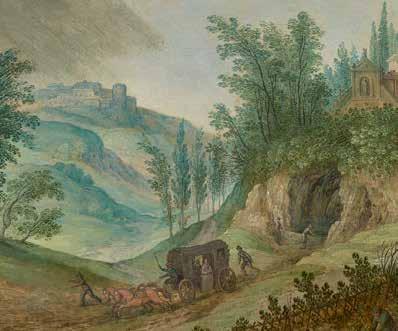
Susan Moore introduces the agents who risked death to build the Earl of Arundel’s superlative collection of art
26 Cutting edge
He returned from the dead to revolutionise the art of painting.
Alastair Smart examines the astonishing legacy of Italian canvas-slasher Lucio Fontana
32 Fast lane
Behind the jokes, there were four wives and a lifelong struggle with depression. But Peter Sellers found solace, Neil Lyndon writes, in his cars
38 Family
business
When Manfred Schoeni met Zeng Fanzhi and Yue Minjun, he uncovered Hong Kong’s contemporary art scene.
Emma Crichton-Miller speaks to his daughter Nicole about the generation of artists he introduced to the world
42 The eyes have it
The charismatic actor Alain Delon bought with his eyes and his soul. Alexandre Crochet charts the artistic sensibility that developed alongside his film career
50 God
of small things

Bhupen Khakhar started out as an accountant from a dull city –and turned into a global artistic superstar, Mark Hudson recounts
54 Chain
reaction
Alexander Fleming’s discovery of pencillin was only the first step on its journey to changing the world. It was Nobel prize-winner Ernst Chain, argues Robert Bud, who brought the ‘wonder drug’ to the masses
58 Summer days
What was it about the village of Mells that so inspired William Nicholson? Its congenial residents, of course, says Matthew Sturgis
Columns
6 News and forthcoming events
15 Inside Bonhams
Asaph Hyman, Global Head of Chinese Ceramics and Works of Art, tells Lucinda Bredin the key to his department’s success
63 Wine
Small terroir, big influence. Richard Harvey reports on Burgundy
65 Around the globe
70 International directory
72 My favourite room
Griff Rhys Jones
Front cover
Raoul Dufy (1877-1953)
La baie de Sainte-Adresse, 1906 (detail) signed and dated ‘Raoul Dufy 1906’ (lower right) oil on canvas 65 x 81.3cm (25½ x 32in)
Estimate: €600,000 - 800,000
(£500,000 - 700,000)
Sale: Alain Delon: 60 Years of Passion
Paris | Thursday 22 June
See page 42
Bonhams Magazine | 3
Issue 75
Contents
22 26
Art de l’Avant-Garde à nos jours
Paris
Wednesday 7 June 2pm
George Mathieu (1921-2012)
Le Duc d'Alençon
1959
Oil on canvas
89 x 146cm (35 x 57½in)
Estimate: €150,000 - 200,000
($160,000 - 220,000)
Enquiries: Giacomo Balsamo
+44 (0) 20 7468 5837
giacomo.balsamo@bonhams.com
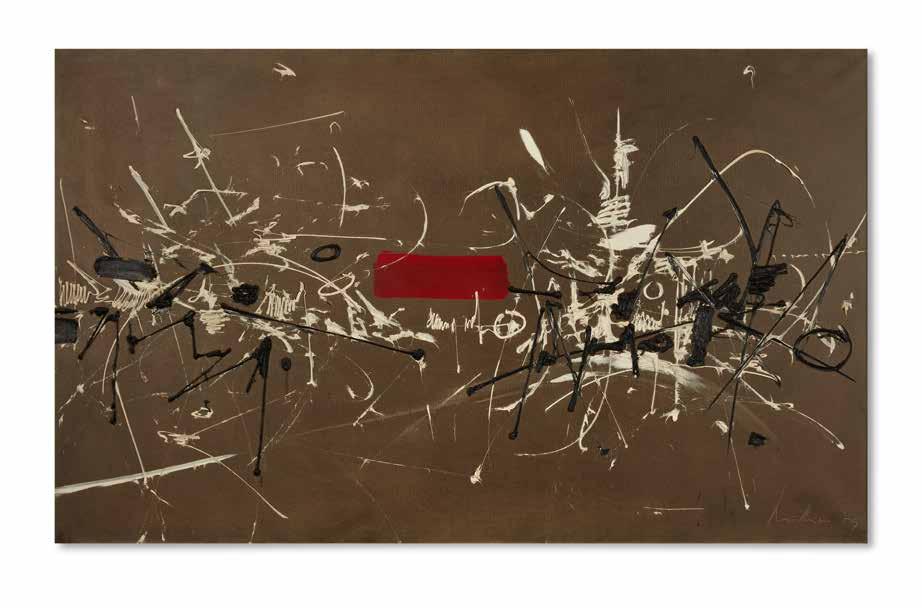
Editor’s letter

‘The collector’s eye’ is one of those terms bandied about by connoisseurs. But over the years I’ve realised that, while seeing an artwork is a prerequisite, many collectors acquire with their heart, head and almost certainly their soul. Alain Delon, the legendary actor, is squarely in this category. He acquired his first work aged 24 when in London – and never quite stopped. After that moment, he got a taste for buying works, never using an advisor, always trusting his own instincts. His collection is being offered at Bonhams Cornette this June and it has already received worldwide attention. Highlights include drawings by Veronese, Beccafumi, Millet; paintings by Delacroix, Dufy, Gleizes –and a number of sensational sculptures by Rembrandt Bugatti. As Delon himself said when summing up his treasures: “There are two things I regard as my legacy: my acting career and my art collection. I am so proud of them both. People ask me if there is a thread that binds these pieces together. I say, “C’est moi!”
Another actor who was a compulsive collector was Peter Sellers. The late and great actor could not stop buying cars (or handbags for his mother…). Alas, Sellers could not have made the same assertion as Alain Delon, as he had no idea who he was when he
Contributors
Alexandre Crochet
Since securing his Masters in Art History at the Sorbonne in Paris, Alexandre Crochet has worked for many art publications in France.



Co-editor of the French edition of The Art Newspaper since its launch in 2018, he specialises in Scandinavian art and the international art market. He tells the story of the French film star Alain Delon, who became a great and refined classic collector.
Susan Moore


Art historian, biographer and art market columnist, Susan Moore writes regularly for the Financial Times and Apollo. Following a biography of Baron Hans Heinrich Thyssen-Bornemisza, her current project is a life of the overlooked American artist Anne Estelle Rice. She founded the not-for-profit Slow Art Workshop in 2017. In this issue, she writes about an enigmatic Old Master work.
Follow us on Twitter: @bonhams1793; email: press@bonhams.com



wasn’t inhabiting a part. Roy Boulting, the film producer, went so far as to say that Sellers was mad. However, Sellers certainly knew a beautiful car when he saw one. In this issue, Neil Lyndon writes about the most desirable car the actor acquired: a 1961 Aston Martin DB4GT, one of the cultural signifiers of its age – and which had its own starring role as the getaway car in the British crime caper, The WrongArmoftheLaw.The motor will hit the block at Goodwood Festival of Speed in July.
Talking of collectors, some things never change. Thomas Howard, Earl of Arundel (1585-1646) was arguably the most illustrious collector that Britain has ever known, writes Susan Moore, with a “peerless” collection of Old Master paintings and Classical sculptures. The Earl began the vogue for the Grand Tour – which became a gap year-cum-finishing school for young English milords – and in doing so he changed the taste of a nation. One of his purchases was a set of six panels illustrating the seasons, and the one for March and April is on offer in July’s Old Master Paintings sale in London. Just as the year has its cycle, so do collectors, and this is the season for the next generation to buy with their eye.

Enjoy the issue.
Griff Rhys Jones

Griff Rhys Jones OBE has been a fixture on television and the stage since his 20s. He has won two Olivier Awards for his theatre performances and, as one of the cast of Not the Nine O’Clock News, was watched by television audiences of 18 million. He has also presented award-winning documentary series, including the BBC’s Restoration. In this issue, he reveals his favourite room.
Robert Bud
Robert Bud is Emeritus Keeper at London’s Science Museum. He curated two exhibitions at the Museum dealing with penicillin, and wrote Penicillin: Triumph and Tragedy. He is the prize-winning author/editor of nine other books. In this issue, he looks at the contribution of Ernst Chain, a refugee from the Nazis, who won a Nobel Prize for his role in developing penicillin.
Joel McIver

Joel has published 35 books on music. As well as writing biographies of leading artists of all genres, he has co-written the memoirs of a number of musicians, including members of Deep Purple, the Spiders From Mars and the Sex Pistols. He writes about Bonhams’ auction of guitars belonging to the late Fleetwood Mac founder Peter Green on page 18.

Conditions. Sale dates may be subject to alteration. Currency exchange rates correct at the time of publication. bonhams.com. Should you no longer wish to receive this magazine, please contact
recording or otherwise without the prior written permission of Bonhams. All dates are correct at the time of publication. All sales are subject to Bonhams
Bonhams Magazine | 5
Editor Lucinda Bredin Editorial Andrew Currie, Sasha Thomas, Lynnie Farrant, Hannah Daniells-Conroy Copy Editor Simon Coppock Designer
Santos Photographs Bonhams Photography Advertising Enquiries renata@parkwalkmedia.com Published four times a year by Bonhams 1793 Ltd, 101 New Bond Street, London W1S 1SR Subscription (four issues) £25 for the UK, £30 for Europe or £35 for the rest of the world, inclusive of postage. Subscription Enquiries Linda Pellett, Bonhams +44 (0) 1666 502 200; ISSN 1745-2643. Issue 75 © Bonhams 1793 Ltd, 2021. No part of this publication may be
by
means, electronic,
&
linda.pellett@bonhams.com
Nathan Brown Assistant Designer Cristina
reproduced, stored in a retrieval system or transmitted by any form or
any
mechanical, photocopying,
Terms
News
In and out of Bonhams’ salerooms


Hot prints
The latest edition of After Hours, which returned to New Bond Street in April, saw Bonhams launch the new Prints & Multiples sale Hot Off the Press in partnership with The Connor Brothers and Teenage Cancer Trust (TCT). A queue of eager collectors formed around the block waiting to purchase one of the two limited edition prints that had been created by The Connor Brothers especially for the launch, with a percentage of the funds raised going to TCT. Both prints had sold out by the end of the night. As DJ Spoony entertained the crowds and cocktails were served, guests were treated to live art and printing demonstrations by Adam Bridgland and Jack Garfield. It meant that everyone was able to walk away with a print of their own – even if they didn’t manage to secure one by The Connor Brothers. But the centrepiece of the evening was a moving thank you, presented by Gaby Roslin on behalf of TCT, accompanied by an emotional poetry reading by young cancer survivor Lauren Dangrish. An impressive total of £40,000 was raised for TCT over the course of the evening.

Marque the date
Held alongside The Quail: A Motorsports Gathering, Monterey’s most exclusive and prestigious annual concours, Bonhams’ Quail Auction – on 18 August at Quail Lodge & Golf Club in Carmel, California – is the longestrunning sale of Monterey Car Week. It is well known for setting world records and presenting the finest collector cars from the most prestigious marques. And they don’t get much more prestigious than this year’s highlight, a very rare 1949 Talbot-Lago T26 Grand Sport (GS) Convertible. With a top speed of 200kph – the engine was modelled on that of the marque’s T26C Grand Prix car – it was among
the most powerful, expensive and desirable production cars of its time. Unlike other TalbotLago models of the late 1940s, the T26 GS was delivered as a chassis, leaving the owner to commission the bodywork. This particular car rejoices in beautiful coachwork by Parisian Master Carrossier Louis Dubos – one of only three short chassis convertibles. Perhaps the last significant Talbot-Lago to remain in unrestored condition, it offers an unrepeatable opportunity to elevate a wonderful car to concours standard.
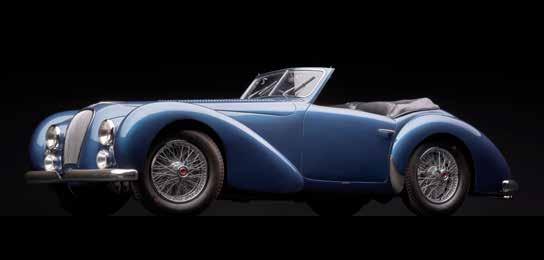
Enquiries: Rupert Banner +1 212 461 6515 rupert.banner@bonhams.com
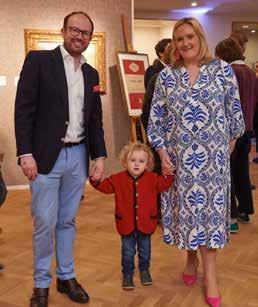
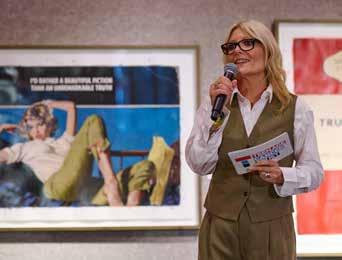

| Bonhams Magazine 6
O
O
Anouska Lancaster
The Connor Brothers
York-Alexander and Carolin von Massenbach and Leopold
Madeleine Cater, Edmund Ratcliffe and Emily Bettis
Gaby Roslin and DJ Spoony
Gaby Roslin
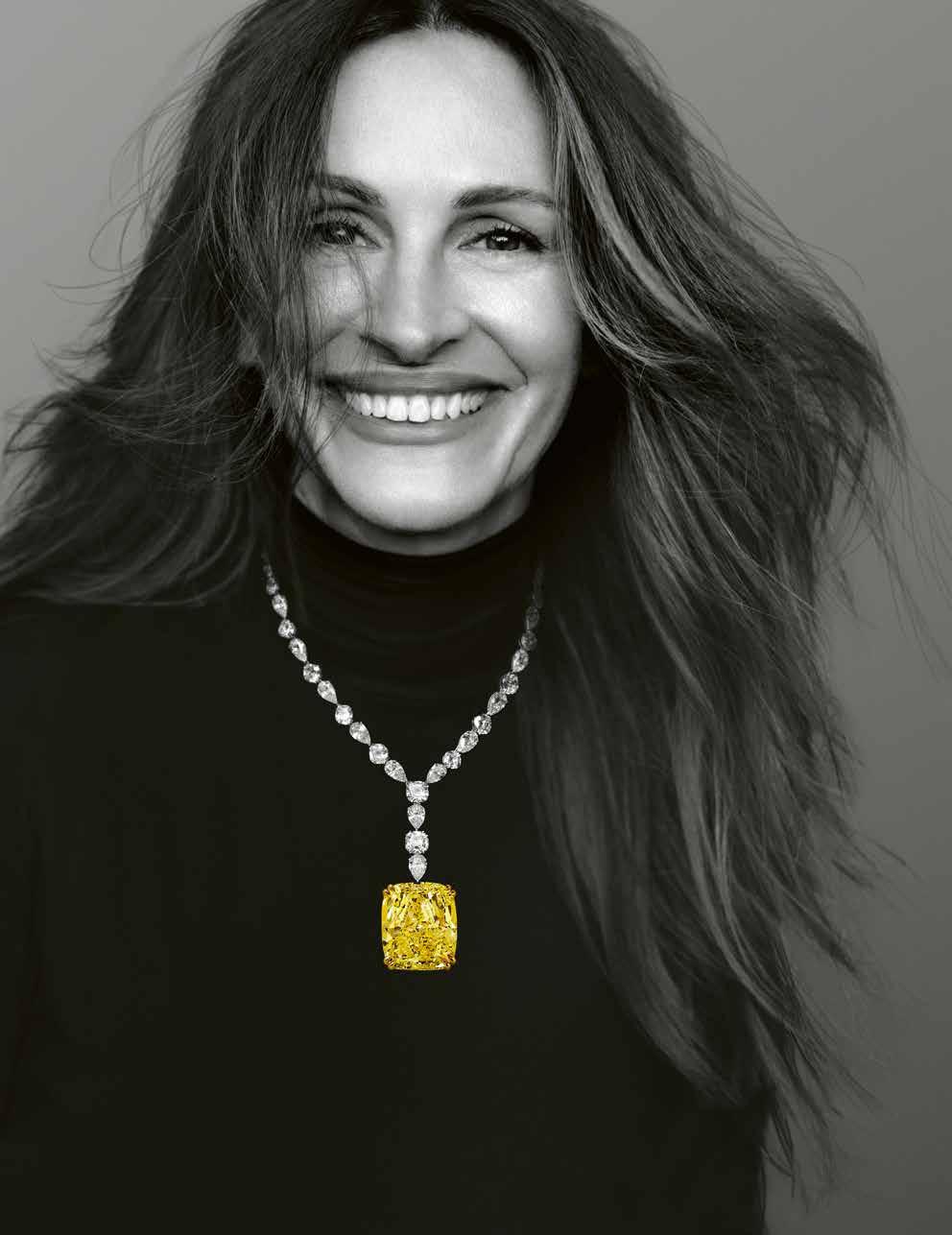
Travel & Exploration Sale
London
Thursday 8 June 11am
Thomas Baines (1820-1875)
Tete, Zambesi River, S.E.Africa (detail) oil on canvas

46 x 66.3cm (18 x 26in)
Estimate: £150,000 - 250,000 ($190,000 - 300,000)
Enquiries: Rhyanon Demery +44 (0) 20 7393 3865
rhyanon.demery@bonhams.com
British brilliance
On 27 March, Bonhams celebrated the return of its annual British. Cool. sale with a party worthy of the title. Capturing the unique creative impulse that has produced Britain’s most revered artists, designers and musicians across the decades, the event immersed its guests in the quintessential cool of the UK’s most influential cultural icons. To the sounds of British hits from The Beatles to Buzzcocks, guests enjoyed cocktails and themed canapés as they admired works of art by Banksy, Tracey Emin, Vivienne Westwood, David Hockney and many more – and even had the opportunity to grab a brush and create art of their own. The evening culminated in a speech by renowned contemporary British artist Bob and Roberta Smith (pictured above), who delivered an uplifting message about the power of art to change the world.




Of Meissen men


In spring 1744, Maria Josepha (1699-1757), Electress of Saxony and Queen of Poland, commissioned a series of busts depicting Habsburg rulers – 12 emperors and five kings in all – from the Meissen manufactory. The busts were to celebrate the ascent to imperial rank of the Habsburg dynasty. The idea may well have come from the Habsburg court in Vienna: Archduchess Maria Amalia, Maria Josepha’s cousin, had visited the Meissen manufactory in March 1744 with her husband, Karl Alexander of Lorraine. And relations between the two courts were warm –Poland Saxony joined the Austrian-led alliance against Prussia in the second Silesian War later that year. It is
not known what Maria Josepha planned to do with the busts, but she does not seem to have taken delivery of them, and there is every possibility that they were intended as diplomatic gifts and, no doubt, reminders of Habsburg might. A bust from the series – that of Charles V (1550-1558), Holy Roman Emperor, Archduke of Austria and King of Spain – will be offered in the 500 Years of European Ceramics sale in London in July.
Enquiries: Nette Megens +44 (0) 20 7468 8348
nette.megens@bohams.com

Bonhams Magazine | 9
O NEWS
O
Antiquities
London
Thursday 6 July 11am
An Egyptian painted wood anthropoid coffin for the lady Irtwrw Third Intermediate Period-Late Period, circa 25th-26th Dynasty, circa 747-525 B.C. 173cm (68in) high Estimate: £100,000 - 150,000 ($130,000 - 190,000)
Enquiries: Francesca Hickin +44 (0) 20 7468 8226 francesca.hickin@bonhams.com

Spring time in Paris
Printemps Asiatique celebrates its sixth anniversary in Paris this June, and Bonhams is staging a rich programme of sales to coincide with the prestigious Asian Art festival.
The Claude de Marteau Collection continues to yield its treasures. Following two successful sales last year, more astonishing pieces gathered by the renowned dealer and collector will be offered in the Claude de Marteau Collection: Part III on 12 June. Among the highlights are a 3rd-century Gandharan bodhisattva statue, more than a metre high (estimate: €400,000 - 600,000), and a 15th-/16thcentury Tibetan gilt copper-alloy figure of the 9thcentury Buddhist master Virupa (estimate: €150,000 - 200,000), renowned for both his wisdom and for his wild behaviour. The statue depicts the famous story of when he raised his left hand to stop the Ganges.
The Chinese Art sale on 13 June offers a highly important wood figure of the Water-Moon Guanyin bodhisattva (estimate: €800,000 - 1,200,000).

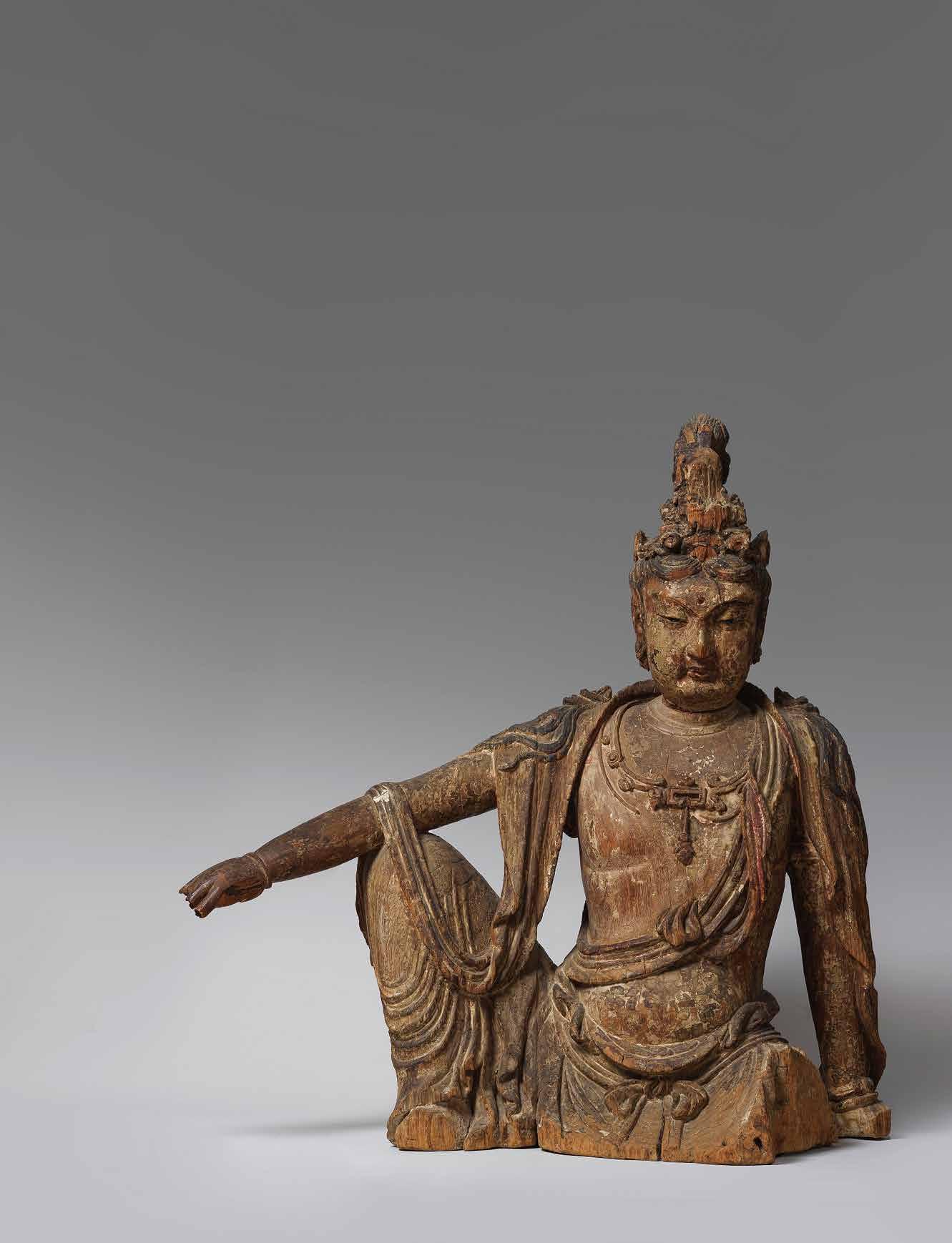
Once part of the fabled Paul Houo-Ming-Tse collection, it comes to auction from a French private collection of the 1930s. Intended for a temple, the figure was made under the Jin Dynasty (1115-1234). The bodhisattva is seated in the pose of ‘royal ease’, his inward-turning gaze and contemplative pose expressing his role as a comforter of human suffering.
Myths, Malice and Magic on 14 June is an intriguing sale of the netsuke and sagemono collection of Guy de Lasteyrie, who owes his lifelong passion for these fascinating objects to his grandmother. Since the 17th century, netsuke have been used by men to help fasten sagemono
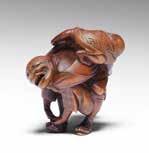
– small boxes for personal effects – to the belts of kimonos. Over time, netsuke became prized as works of art and attracted master craftsmen such as Masanao, Tametaka and Tsuji, whose mid-/late18th-century model depicting an elephant and a karako (little boy) is estimated at €25,000 - 35,000.
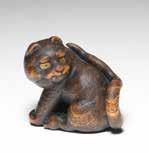
From 9 to 15 June, the Vietnamese Art onlineonly sale features a major work by Le Pho (19072001) from Pierre Le-Tan’s collection. La famille (estimate: €250,000 - 340,000) dates from 1955, when he was painting on silk using gouache and thick oil paint, and is a bucolic depiction of the love between a mother and her child.

Enquiries: Edward Wilkinson +44 (0) 20 7468 8314 edward.wilkinson@bonhams.com
Jing Wen +33 (0) 1 89 53 43 55 jing.wen@bonhams.com
Bonhams Magazine | 11
O
India in Art
London
Wednesday 7 June 11am
A large painting depicting the Battle of Condore in December 1758, during the Third Carnatic War, with East India Company troops under Colonel Forde engaged against French troops and their allies (detail) South India, 19th Century gouache and oil on canvas 82 x 140cm (32 x 55in)

Estimate: £50,000 - 70,000 ($60,000 - 90,000)
Enquiries: Matthew Thomas +44 (0) 20 7468 8270 matthew.thomas@bonhams.com
OEarthly paradise
Colin Tennant, 3rd Baron Glenconner, is probably most associated with the Caribbean island of Mustique, which he acquired in 1958, and his gift of a villa there to Princess Margaret. Lord Glenconner was, however, also a noted art collector and connoisseur: he was an early patron of Lucian Freud. Although his tastes were eclectic, he had a particular fondness for Indian art, even commissioning set designer Oliver Messel to create an ‘Indian palace’ on Mustique. In the late 1980s, Lord Glenconner bought the rare monumental marble and rock crystal lingam that leads the India in Art sale in London in early June. Made in the late 19th or early 20th century, this shrine is an abstract representation of Shiva, signifying that the deity is ultimately without form or gender. The shrine was shown to great acclaim at the much-publicised Puja exhibition at the Sackler Gallery in Washington from 1996 to 2000.
Enquiries: Oliver White
+44 (0) 20 7468 8303
oliver.white@bonhams.com

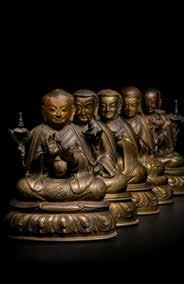

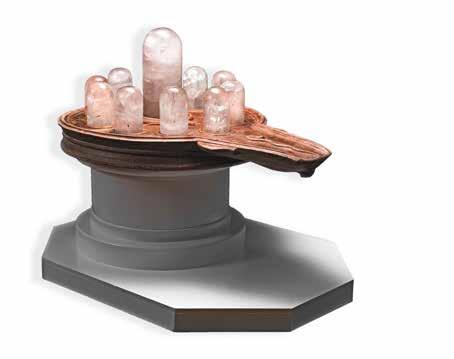
The naked truth
Had Pauline Borghese not been the sister of Napoleon Bonaparte, her life would have turned out rather differently. Spoiled, frivolous and vain –and, by common consent, exquisitely beautiful –she cut a swathe through Napoleonic circles and scandalised Rome by cheating indiscreetly on her equally empty-headed husband Prince Camillo Borghese. (That earned her an exasperated telling-off from her big brother.) On the plus side, she was likeable, unmalicious, and intensely loyal to Napoleon, whom she even joined in exile on Elba – the only one of the deposed Emperor’s siblings to show any concern. Famously, she posed naked for Antonio Canova, the leading sculptor of the era. When someone asked whether she had felt uncomfortable baring all for the artist, she sweetly pointed out that there had been a fire going. Canova also produced a portrait bust of Pauline, which he presented to the Duke of Wellington in 1816 in gratitude for the latter’s help in returning works of art taken from Rome by Napoleon. Hailing from Canova’s own studio, a copy of the bust – known as Portrait of a Dancer – features in the Fine Decorative Arts sale in Bond Street in July.
Enquiries: Michael Lake +44 (0) 20 7393 3890 michael.lake@bonhams.com
Vroom broom
Harry Potter is one of those rare cultural figures instantly recognised everywhere on the planet. The seven novels by J.K. Rowling featuring the Boy Wizard and his adventures at Hogwarts School have been translated into 85 languages and sold more than 600 million copies; the eight-part film series based on the books grossed more than $7.7 billion and the Harry Potter franchise – including merchandising – is worth more than $25 billion. One of the highlights of the Hollywood Then and Now sale in Los Angeles on June 6 is Draco Malfoy’s Nimbus 2001 racing broom, as used by actor Tom Felton during the filming of Harry Potter and the Chamber of Secrets, the second film in the series. The broomstick, estimated at $70,000 - 90,000, is a ‘hero prop’ – that is, a high-quality and detailed version that was used by the main actor in close-up scenes and promotional photography. Malfoy – Harry’s arch enemy – can be seen riding the broom in a house match of the high-tempo aerial game Quidditch, when he and his slippery cronies from Slytherin take on Harry and his friends from Gryffindor.
Enquiries: Joe Moe +1 323 436 5436 joe.moe@bonhams.com
What happened next...
Bonhams Magazine | 13
NEWS O
O
Old Master Paintings
London
Wednesday 5 July 2pm
John Russell R.A. (1745-1806)
Portrait of Thomas Sheppard, full-length, in a blue coat and yellow breeches with his spaniel one of a pair, oil on canvas
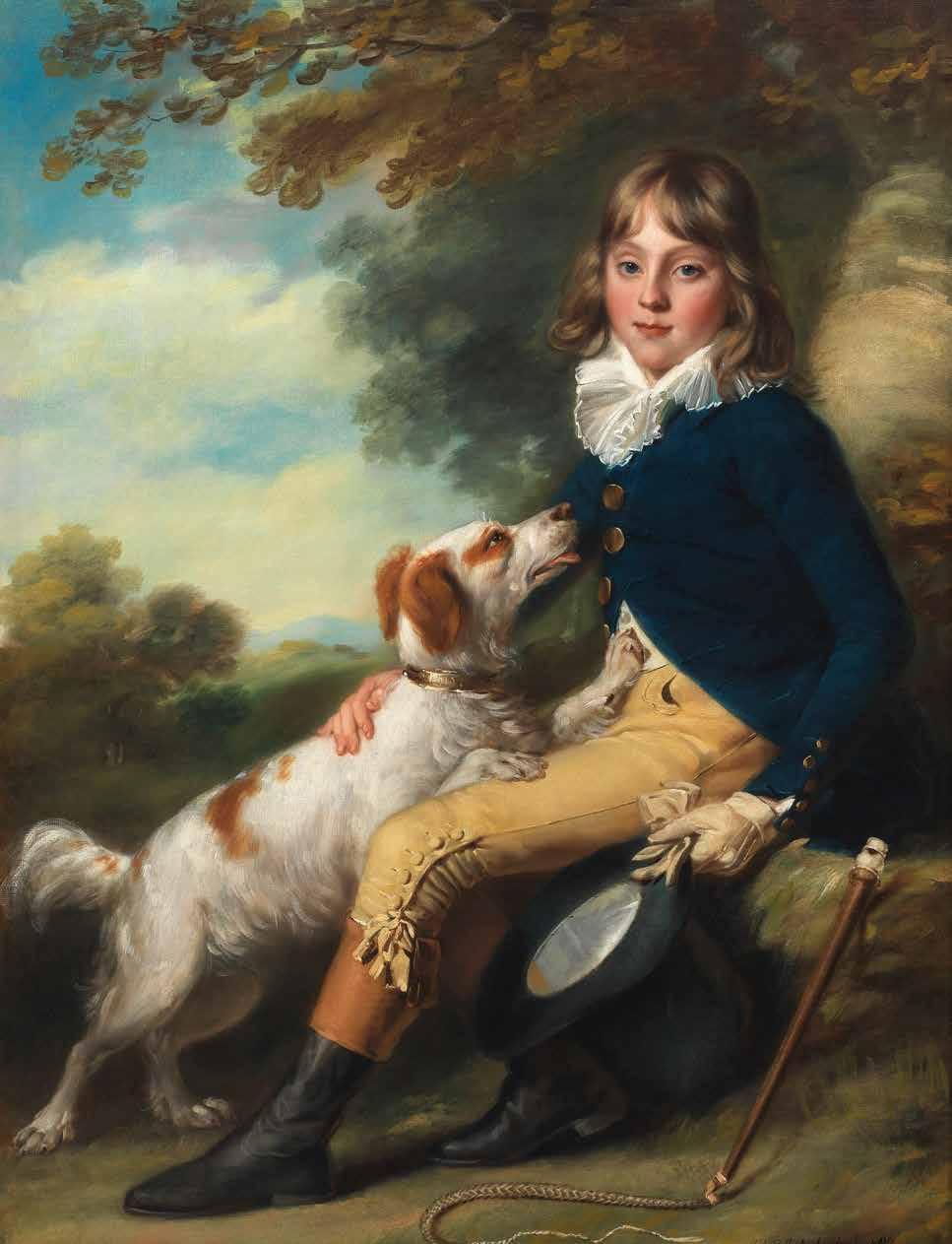
1792
115.1 x 87.2cm (45 x 34in) (2)
Estimate: £150,000 - 250,000 ($200,000 - 320,000)
Enquiries: Lisa Greaves +44 (0) 20 7468 8325 lisa.greaves@bonhams.com
In his court
Right
Asaph Hyman runs one of the most prestigious and successful operations at Bonhams – indeed, in the entire Asian art world. His department had a global turnover in 2021 of more than £54 million. During the past year alone, he has sold several multimillion-dollar collections: in London, two sales from the collection of pre-eminent dealer Roger Keverne, the H Collection and the Parry Collection; in Paris, the Rousset family collection; and, in New York, the Cohen & Cohen, J.J. Lally and Mary and Cheney Cowles collections.
Asaph still remembers his first encounters with the past. “As a boy in Jerusalem, I discovered Roman coins, bits of figurines and Herodian ceramic shards in a valley outside the Old City. I remember coming across the bronze seal of a Palestinian mukhtar – head of a village –from the late Ottoman period in that valley. I was hooked.”
The journey from budding Indiana Jones to Bonhams’ Global Head of Chinese Ceramics and Works of Art was not straightforward, however, with Asaph choosing a more pragmatic career than archaeology. “I trained as a lawyer”, he says. “After graduating, I had the fascinating

experience of working for the late Justice Cohn, former Deputy President of the Israel Supreme Court. Although I enjoyed the law – and my training taught me to think analytically and rigorously – I realised there was something missing. I moved to London and enrolled on a course in Fine and Decorative Arts. There I was incredibly lucky to have as my tutor and mentor the late Gordon Lang, and it was Gordon who initiated me in Chinese art. Within two weeks, I knew where my future lay.”
“It is”, he says, “a tremendous privilege and a great accolade when people who have been at the top of their game for years, like Roger Keverne and Miranda Clarke and the Cohens, ask us to sell their collections. They chose us because they trust us to do a good job. And they know that we care about the objects. With the Keverne sales, for example, every one of the 801 lots was studied and researched, irrespective of its potential value. The attention to detail was a major factor in our success –both sales were white glove [every lot was sold] – but this is just how we approach all our sales.”
Asaph is keen to emphasise that teamwork is key. “Everyone in my department is keenly aware of our strong obligation to do our best for clients. Whether someone is selling a single item or an entire collection, it’s a major event for them. That reputation for caring for our vendors, whoever they are, makes a real difference and translates into sales. Buyers, too, know we do our homework.”

Bonhams Magazine | 15 INSIDE BONHAMS
From lawyer to leader of one of Bonhams’ most successful departments, Asaph Hyman tells Lucinda Bredin how it all went right
Below
A huanghuali recessed-leg wine table, Jiuzhuo Ming Dynasty (late 16th to early 17th century) sold for $1,980,375
Asaph Hyman, Bonhams’ Global Head of Chinese Ceramics and Works of Art admires the Shakyamuni Buddha offered in London’s Fine Chinese Art sale
Below
A memorable lot: an exceptionally rare imperial Beijing Enamel teapot, Qianlong mark and period (1736-1795) from the Parry Collection, sold for more than £2 million

He is equally clear on the importance of Bonhams’ global network. “As a global team, we work together to offer more choice to our clients. The Cohen & Cohen sale is a good example. The firm was based in London, but the strongest market for their Chinese export porcelain was in America. Our international reach means we were able to offer the option of selling in New York. And the sale Cohen&Cohen:50YearsofExportPorcelainwas a triumph, making well over $1.5 million.”
The opening of a Chinese department in Paris and the acquisition of Bruun Rasmussen, Bukowskis and Skinner, all of which have established Asian Art departments, has added more strings to his bow. One of the highlights of the Chinese Art Sale in London in May, for example – a giltbronze figure of Shakyamuni Buddha – was consigned as a direct result of working with colleagues in Copenhagen.
Asaph joined Bonhams’ Chinese Art department in 2007 – “I was very fortunate to enter the business at a boom time”, he says. “Tastes have changed, of course –the current hot areas are Classical Chinese furniture and jade carvings from the Neolithic to the 2nd century AD, a market we helped to create – but the main transformation has been a passing of the baton from West to East.
“In the West, collecting Modern and Contemporary Art is now favoured over antiques, including Chinese art. Because there are fewer active collectors of Chinese art in Europe and the States, when long-established dealers retire there’s no new generation to replace them, unlike in the past. Most collectors are now based in Asia and, understandably, will often feel more comfortable taking advice locally, rather than from someone in the West, however experienced they might be.”
Asaph identifies two other factors. Mainland Chinese buyers prefer to buy at auction rather than from dealers, because the price and the process are very public and therefore more transparent. This has limited the ability of dealers to sell privately. And then Covid had its own impact on the way buyers engage. “In the Chinese art market, it was always taken as read that potential buyers
Left
A magnificent gilt-bronze figure of Shakyamuni Buddha, Yongle-incised six-character mark and of the period (1403-1424)

Estimate: £300,000 - 500,000 ($400,000 - 650,000)
Below
A very rare Shang Dynasty bronze ritual wine vessel from the Keverne sales, sold for £187,750

would want to inspect an object in person. Obviously Covid put a halt to that. We responded by producing many more photos and videos, so that our clients could get a better understanding of objects. We were pleasantly surprised to find that they were willing to bid on that basis. The Roger Keverne sales, for example, took place when travel from China was impossible, and I know that people held parties in Hong Kong to stay up for auctions. There were so many bidders that each of the sales took more than 15 hours to complete – a Bonhams record.”
What has been Asaph’s most memorable lot? “It’s often not just about the objects, but also the history of the collection. One I often come back to is the Parry Collection. The pieces were wonderful, but the family had also kept invoices dating back to 1919 – 100 years of collecting, and a window into an era now gone. There was a magnificent painted enamel imperial teapot, one of only three in the world, that was just a pleasure to behold and it sold for more than £2 million. But it’s the combination of the objects, the collection, the collectors and their history that adds up to something special.”
Lucinda Bredin is Global Director of Communications at Bonhams.
| Bonhams Magazine 16 INSIDE BONHAMS
Mythes, Malice et Magie: La collection de netsuke et sagemono de Guy de Lasteyrie
Paris
Wednesday 14 June 2pm
A Wood Netsuke of a
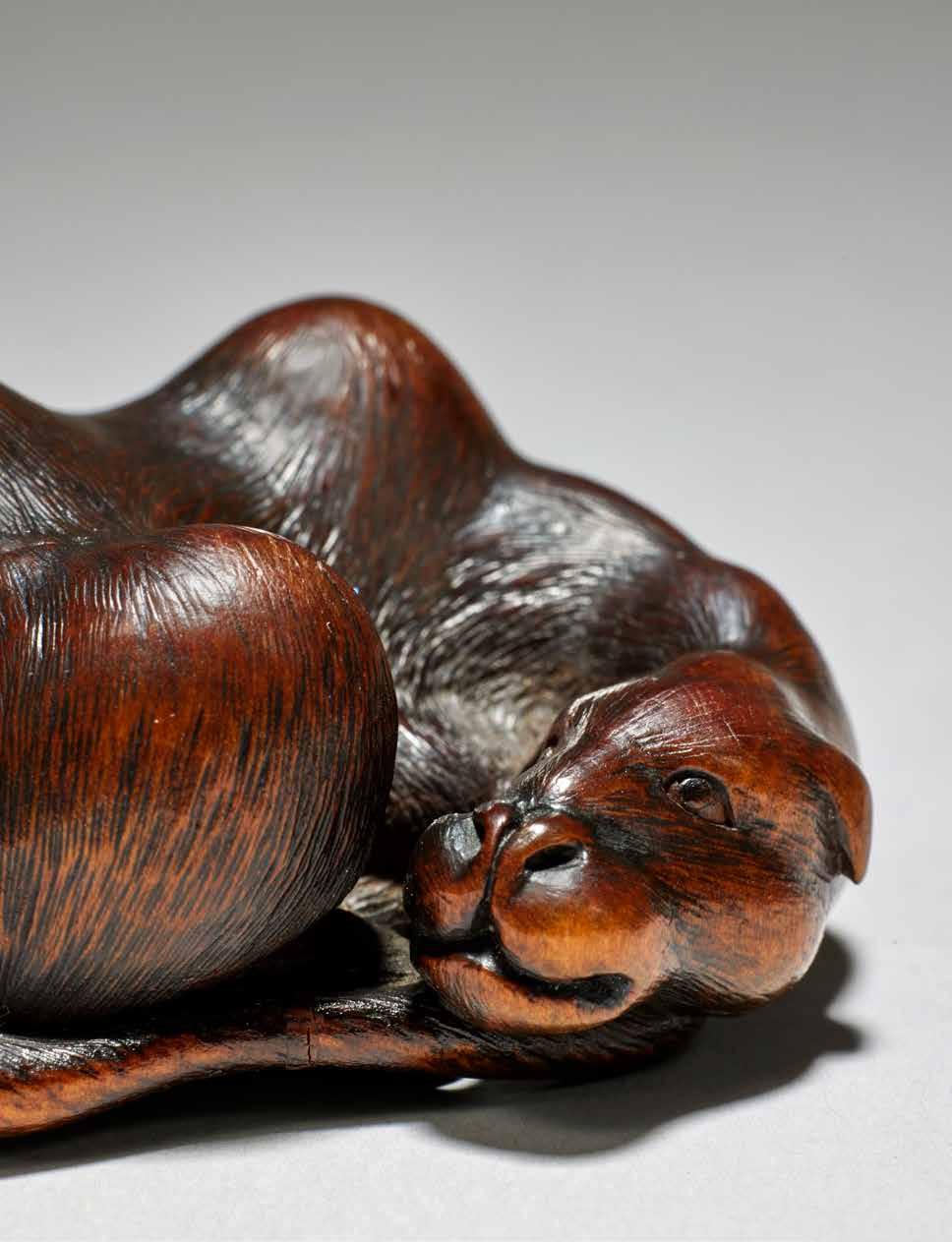
By Hogen Tadayoshi, early/mid-19th century
Estimate: €25,000 - 30,000 ($30,000 - 45,000)
Enquiries: London: Suzannah Yip +44 (0) 20 7468 8368 suzannah.yip@bonhams.com
Paris: Anna Tchoudnowsky +33 (0) 1 89 20 04 66 anna.tchoudnowsky@bonhams.com
Recumbent Bactrian Camel

Strung out
Electric bluesman B.B. King praised his intense musicality, writes Joel McIver, but Peter Green, Fleetwood Mac’s original guitar wizard, was too fragile for rock stardom
When Fleetwood Mac’s founder, the guitar maestro Peter Green, died in 2020, tributes came thick and fast. Mick Fleetwood, who had been invited by Green to join his band and lent them his surname in doing so, wrote: “No one has ever stepped into the ranks of Fleetwood Mac without a reverence for Peter Green and his talent, and to the fact that music should shine bright and always be delivered with uncompromising passion.” Bruce Springsteen’s guitarist Stevie Van Zandt – known to millions as Silvio Dante on HBO’s TheSopranos–described him as “one of the great guitar players of all time… He somehow managed to follow Eric Clapton at his peak. That’s how good he was.”
Dig a little deeper into those accolades, though, and you’ll unearth a sense of regret: a subtext of sadness that the great guitarist never matched the commercial heights scaled by Fleetwood Mac after he left the group in 1970. His life was troubled, and his output less prolific than it should have been. While many guitar players know who Green was, the wider public generally do not.
This is what makes Bonhams’ forthcoming online auction of the Peter Green Collection in June more than just a guitar sale. It’s a unique opportunity to get close to
the blues that were the heart and soul of early Fleetwood Mac, and to understand why Green was so fêted as a musician, even though the lifetime of success that he deserved was denied him.
These sought-after guitars, from a collection of 150 instruments, accompany a collection of Green’s psychedelic sketches and – of huge relevance to Fleetwood Mac fans – several of his lyric sheets. Significantly, the latter include the extremely rare handwritten words for the group’s 1969 hit ‘Man of the World’. Anyone searching for a way into Green’s mind at this early stage in his career will find his words prophetic, given his struggles in later life. “I could tell you about my life/And keep you amused I’m sure,” he writes. “About all the times I’ve cried/And how I don’t want to be sad any more/And how I wish I was in love.”

Bonhams Magazine | 19
“Music should shine bright and always be delivered with uncompromising passion”
POPULAR CULTURE
Opposite Peter Green (1946-2020), who set a new standard for guitarists to come
Left
A Fender Stratocaster USA Custom Shop Relic Electric Guitar, 1999 Estimate: £5,000 - 6,000 ($6,000 - 7,500)
Left
Perhaps Green’s suffering led him to be a better guitarist: they certainly brought him closer to the spirit of the blues, although he always insisted the genre be identified as the domain of African-American musicians.

Above
Estimate:
($4,000
(
Born Peter Allen Greenbaum on 29 October 1946 in Bethnal Green, east London, into a Jewish family, he was the youngest of Joe and Ann Greenbaum’s four children. Having been taught basic guitar chords by his brother Michael, Green was already playing professionally by 1961. His first gig was as bass player for Bobby Dennis and the Dominoes, a covers act. Moving rapidly through groups called the Muskrats and the Tridents, he found a place as lead guitarist in the songwriter Peter Barden’s band Peter B’s Looners –whose drummer was one Mick Fleetwood.
But Green first came to prominence in 1966 when he joined John Mayall & the Bluesbreakers, a group that functioned as a boot camp for many great blues and rock musicians. Fleetwood and bassist John McVie had also been Bluesbreakers – alongside Eric Clapton, who had a reputation as the finest electric blues player in the world.
It speaks volumes about Green that he could match, even outperform, the more experienced Clapton. Mayall spotted his prodigious talent early, telling producer Mike Vernon: “He might not be better [than Clapton] now, but –you wait – in a couple of years he’s going to be the best.”
In 1967, Green quit the Bluesbreakers to form the cumbersomely titled ‘Peter Green’s Fleetwood Mac, also featuring Jeremy Spencer’. Their debut was in August at the Windsor Jazz and Blues Festival. If you want an idea of the early Mac sound, look no further than their self-titled debut album of 1968. It’s a universe away from the slick yacht-rock that the group were making a decade later: Fleetwood Mac is unsophisticated electric blues, made by a young, excited band. The only real virtuosity comes from Green through his remarkable guitar playing, notably on his own composition ‘Black Magic Woman’.
Opposite
A
Raw the music may have been, but Green’s mindset soon wandered to a higher plane, inspired by LSD and the counterculture of the day. “There is something mystical that went all the way from Peter Green’s Fleetwood Mac straight through all of them,” pondered the group’s future star Stevie Nicks. “It didn’t matter who was in the band –it was always just there.”
Estimate:
($7,500 - 10,000)
Opposite
In November 1968, Fleetwood Mac enjoyed a sizeable hit in the UK with the single ‘Albatross’, the pinnacle of Green’s songwriting. Whether you know you have or not, you’ve often heard this piece of ethereal blues, whether in TV adverts or as incidental music in any number of settings. The single made Number 1 in the UK and entered the Top 10 in charts across Europe.
Estimate:
($2,500 - 4,000)
As the Sixties swung to a close, Green’s focus shifted: he had begun to perform in a mystic’s robe, and often talked about the idea of the band giving all

20 | Bonhams Magazine
A Gibson Howard Roberts Fusion III SemiAcoustic Guitar, 1995
Estimate: £4,000 - 5,000
($5,000 - 6,000)
A National Duolian Style-O Acoustic Guitar, 1931
£3,000 - 5,000
- 6,000)
Green is pictured with the same instrument opposite, top left)
top right
Gretsch White Falcon
6137 Stereo SemiAcoustic Guitar, 1968
£6,000 - 8,000
right
A Squier Strat Special Edition 20th Anniversary Standard Series Electric Guitar, 2001
£2,000 - 3,000
“Mayall spotted his prodigious talent: Green could match, even outperform, the more experienced Clapton”
their money away. By the end of the decade, his mental health had begun to deteriorate, fuelled by excessive drug use. “I was very critically ill for a while there, you might say,” he told the LosAngelesTimesin 1998. “I’m not really back yet.”
Peter Green’s time leading Fleetwood Mac came to an end rather suddenly, when he visited a commune in Munich late in 1969 and was spiked with bad acid. This provoked a mental breakdown with major consequences for Green. Leaving the band in May that year – never to return – the guitarist embarked on a chaotic, unproductive period that lasted many years. It wasn’t until 1996 that the mostly recovered Green stepped on stage with his new band, the Splinter Group.
The new outfit made eight albums, and Green finally began to enjoy widespread recognition as a pioneer of his instrument: along with other members of Fleetwood Mac, he was inducted into the Rock & Roll Hall of Fame in 1998. Even after that, he had time for one final creative surge, touring from 2009 as Peter Green and Friends.
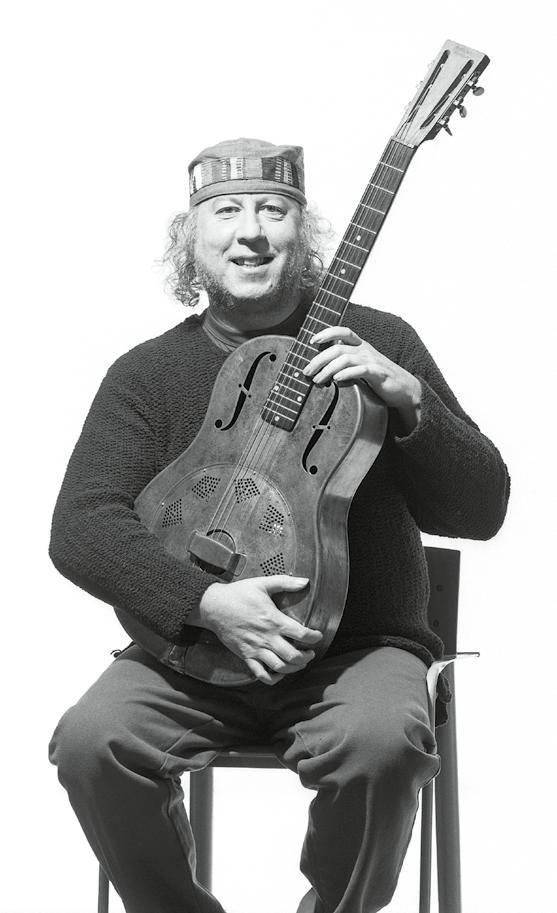
Despite his problems, he made it all the way to 25 July 2020, when he died peacefully at the age of 73. His music – and now his guitars – remain as a powerful legacy.
These are instruments that even the cognoscenti salivate over. The vintage guitars include a Gretsch White Falcon from 1968 and a National Duolian Style-O acoustic from 1931. Then there’s a modern classic: the 1995 Gibson Howard Roberts Fusion III semi-acoustic that Green was playing when he made his pre-millennium comeback with the Splinter Group at Buxton Opera House.

Of course, no self-respecting rock star collection would be complete without a Fender Strat. The auction includes a Stratocaster from 1999 in Sea Foam green and a 20th Anniversary Standard Series Strat from Squier – there’s footage online of Green playing this guitar in 2008 at the Canvey Island Sessions.
It’s a measure of the reverence still felt towards Green that his 1959 Gibson Les Paul, was acquired in 2014 for close to $1m by Metallica guitarist Kirk Hammett. It says even more about Green as a musician that Hammett was advised to buy it by Led Zeppelin’s Jimmy Page.
But perhaps the ultimate accolade came from the blues master B.B. King, who said Green had the sweetest guitar tone he’d ever heard. King added: “He was the only one that gave me the cold sweats.” Now you can experience that thrill too.

Joel McIver is the author of 35 books on music and often appears on TV, radio and podcasts.
Sale: The Peter Green Collection (online) Friday 16 June until Wednesday 28 June Enquiries: Katherine Schofield +44 (0) 20 7393 3871 katherine.schofield@bonhams.com
Bonhams Magazine | 21
“Blues master B.B. King said, ‘He was the only one that gave me the cold sweats’”
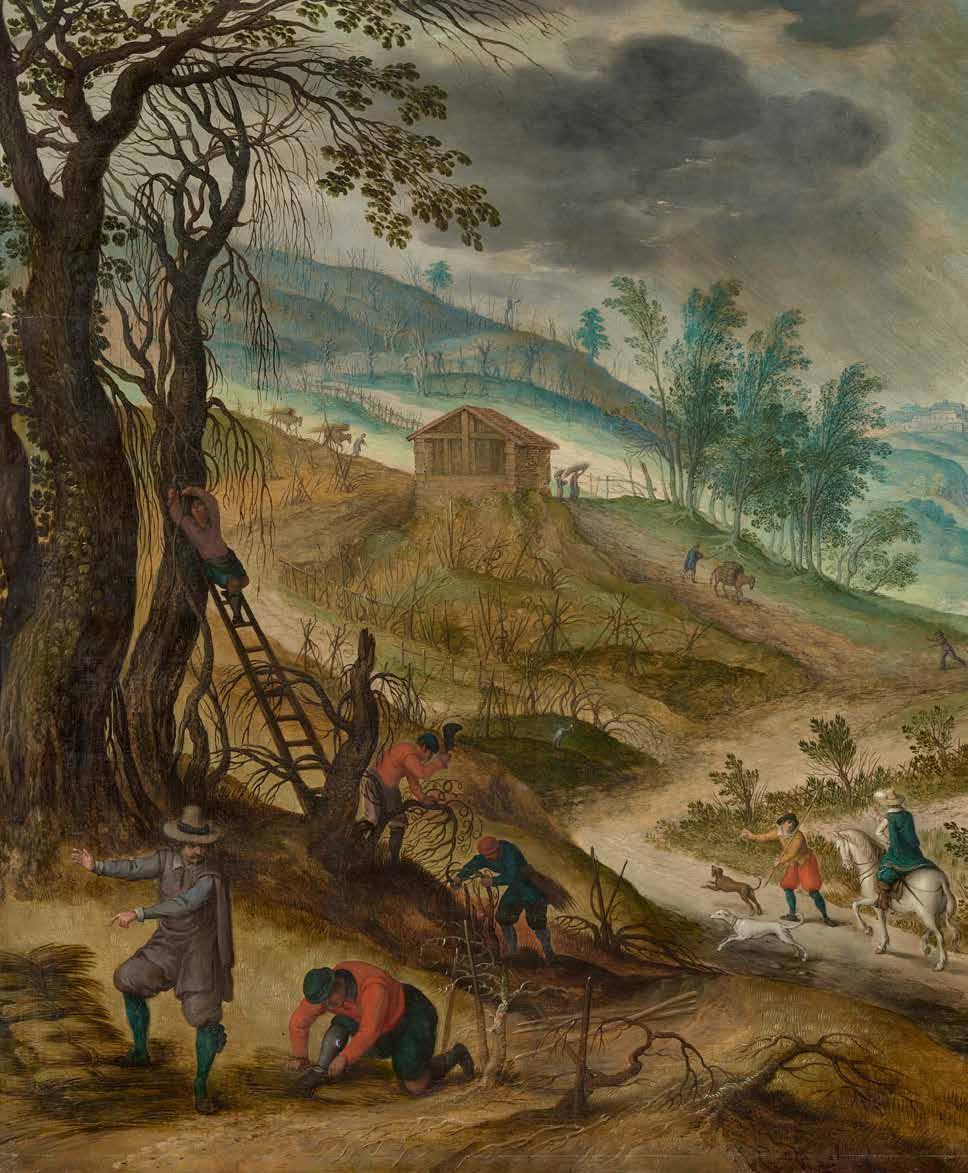
| Bonhams Magazine 22
Spring awakening
The times were brutal, writes Susan Moore, but from them came art of bucolic joy and captivating detail
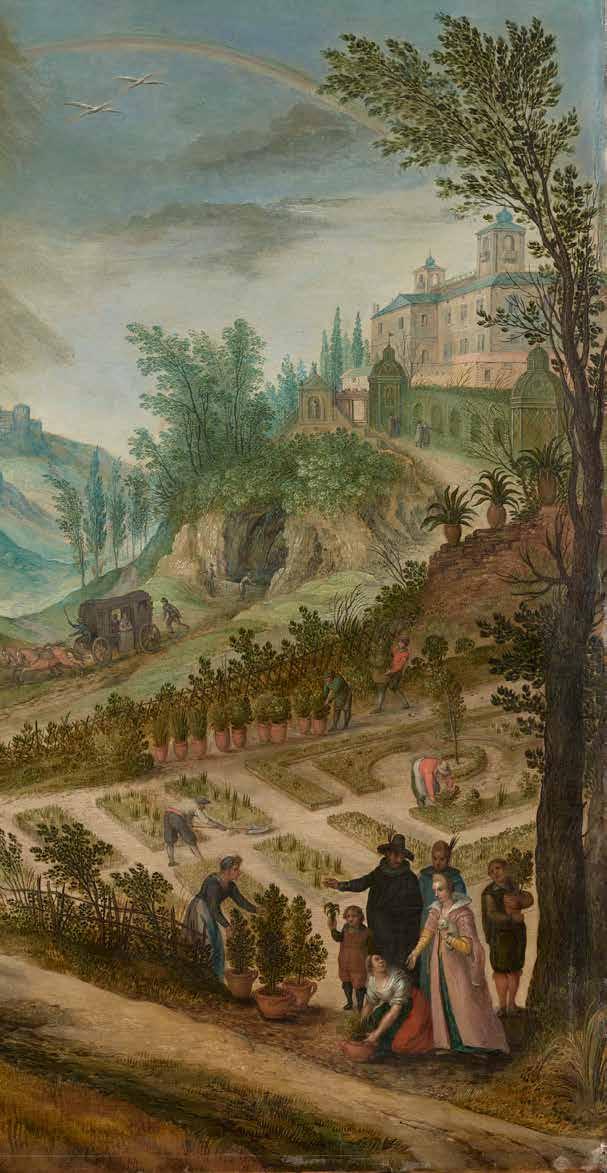
Thomas Howard, Earl of Arundel was arguably the most illustrious collector and patron of the arts Britain has ever known. He amassed every form of art, including a peerless collection of Old Master drawings, exceptional paintings, and classical Greek and Roman sculpture and gems. Although a widely travelled diplomat and early ‘Grand Tourist’ – he made his first trips to the Low Countries and Italy in 1612 –Arundel relied heavily on a network of agents to source his treasures. Among them was William Smith, a painter of modest talent based in Rome who proved far more gifted at seeking out great art than producing it. His shipment to Arundel of 1625 – according to the customs inventory – included some ‘25 modern Flemish landscapes’. Almost certainly among them was a series of six panel paintings, each illustrating two consecutive months of the year – with the one for March and April offered in Bonhams’ Old Masters sale in London in July.
Such cycles were something of a Flemish speciality. Their imagery derived from the calendars of medieval Books of Hours in which the evolving year was captured in changing seasonal activities of both agricultural labourers and their leisured masters. The great Pieter Bruegel the Elder (c.1525/3069) then plucked these very human scenes of daily life from the margins of illuminated manuscripts to set them centre-stage in large-scale landscapes. As the prints made after this
Bonhams Magazine | 23 OLD MASTER PAINTINGS
Main image Attributed to Sebastiaen Vrancx (1573-1647)
Allegory of the months of March and April, with the Villa Medici Estimate: £100,000 - 150,000 ($130,000 - 200,000)
particular series suggest, they had been commissioned from the highly successful painter, printmaker, and draughtsman Paul Bril (c.1554-1626).
Bril employed various assistants in his Roman studio, among them Sebastiaen Vrancx (1573-1647) and Jan Brueghel the Elder, all three indebted to the elder Pieter Bruegel. Bril, having trained in Antwerp, established himself as the leading landscape painter in Rome, patronised by three Popes and most of the Eternal City’s prominent families. His paintings ranged from Biblical and mythological scenes set in lush landscapes to views of the villas and country estates of the landed aristocracy, and huntsmen out for sport. In the allegories of the months, several of these themes come together.
Of the six paintings in the series, five are known. Bril signed the first. January/ February shows herdsmen bringing cattle to market and the Piazza del Popolo in Rome during Carnival, a shop sign here bearing the artist’s punning signatory device – a pair of spectacles (brilin Flemish). It seems he produced compositional preparatory sketches for the entire series, representing all 12 months, and dated 1598. One of these pen and ink drawings, now in the Musée
du Louvre, features a tree and ladder almost identical to those in this painting, with men similarly staking trees on the hillside. A slightly adapted castle and pergola sit to the left. With a generous slice of artistic licence, well-observed details of real buildings and natural features have been confected into an idealised landscape rich in anecdotal detail. And the artist responsible for this transformation is believed to be Vrancx, who was in Italy from c.1596 to 1601.

But the series was recorded in 1655 – in the inventory made after the death of Arundel’s wife, Alethea – as being
by ‘Paolo Fiamengho’. Passing down through the Howard family and the Dukes of Norfolk, the series was split up and sold in 1938, and the panels were attributed to other artists.
What of Vrancx? He was a talented figure painter, who would provide the staffage for numerous other artists, as well as producing his own paintings. Here he provides an array of incident.

March is the month for pruning trees and tilling the soil for planting. In the left foreground of his panel, we see men trimming vines that have been trained to grow up trees. One of them is perilously

| Bonhams Magazine 24
Above
The Shipwreck of St Paul from the circle of Paul Bril, sold at Bonhams in 2003
Below Chasse au Cerf by Paul Bril
Bottom Pieter Bruegel the Elder’s masterpiece, The Tower of Babel, c.1563
“My good servants… were on Wednesday last… most inhumanely murdered, God knows by whom…”
perched up a ladder and leaning against a tree trunk to reach up to cut the chosen branch. Below, the dead wood from the vine is bound into faggots for burning, a foreman instructing the labourer where the bundles are to be laid. Similar scenes are echoed up in the distant, hazy, green-grey hills, where tiny figures are almost indistinguishable from the trees on which they work.
To the right is a scene suggestive of more temperate April, the time for venturing out of doors after winter – riding out, walking, visiting and courtship. The lady of the house, pup or lap dog in her arms, is in her garden supervising the arrangement of the terracotta pots that have presumably been overwintered indoors. Behind her, more verdant shrubs or herbs are being planted in formal raised beds while the paths of gravel or hard-packed earth between them are being prepared. Even the middle distance is full of the very un-Italian, painstakingly rendered details that evidently delighted local patrons. Elegant couples stroll alongside the pergola below the castle gates, while men refresh themselves at a rockpool and a dog barks at a standing heron. There is a sense that all is well in this ordered world, where the rich enjoy
the pleasures of country life and dutifully industrious labourers are decently dressed and well fed. Vrancx ingeniously conjures this season of sunshine and showers. A pale rainbow arching above a pair of herons in flight spans from looming rain clouds to sunlit castle towers. Below, he makes good use of the alternating play of light and shade on the landscape. Like the zigzag paths meandering into the distance, these zones of dark and light were a device favoured by Bril and much imitated. Vrancx uses them here to lend structure to the composition and suggest great depth of field. This conceit was related by the English connoisseur Edward Norgate, another of Arundel’s agents in Rome: “Yet one generall rule I had from my old friend Paolo Brill, which hee said will make a Lanscape ‘Caminare’, that is move or walke away, and that is by placing Darke against Light, and light against Darke. His meaning is best understood by Circumlocution, viz. that what part of your Lanscape soever is light, the next adiacent ground to be proportionably darke, or shadowed, and that again second with light and then shady againe, till you come to the nearest ground, where all ends with strong and dark
shadowes, to sett of all the rest.”
As for poor William Smith, he suffered a dreadful fate. Having worked for Arundel for two decades in various capacities, he would meet a grisly end while serving as a trumpeter on Arundel’s embassy to the Holy Roman Emperor Ferdinand II in Vienna in 1636. These were desperate times. It was at the height of the Thirty Years’ War and so dangerous was their passage up the Rhine that musketeers walked along the riverbank to guard them from attack. As Arundel wrote to another agent, William Petty, “I am oppressed with grief for the loss of my good servants Lamplugh and William Smith, ye trumpeters, who were on Wednesday last, at noonday the first Post on this side of Nuremberg, most inhumanely murdered, God knows by whom… God give me grace to bear it with patience, and send us all free from like misfortune…”.
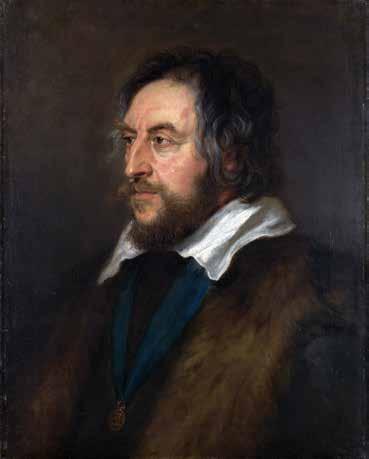
Susan Moore writes for the Financial Times
Sale: Old Master Paintings

London
Wednesday 5 July
Enquiries: Lisa Greaves +44 (0) 20 7468 8325
lisa.greaves@bonhams.com
Bonhams Magazine | 25 OLD MASTER PAINTINGS
Above The Procession to Cavalry, another of Bruegel’s large-scale scenes filled with incident
Right Thomas Howard, 21st Earl of Arundel, “arguably the most illustrious collector and patron of the arts Britain has ever known” in a portrait by Rubens
Below
Lucio Fontana (1899-1968)
Concetto Spaziale, Cratere, 1968 painted porcelain
38 x 28 x 5cm (14¾ x 11 x 1¾in)
Estimate: £18,000 - 25,000 ($25,000 - 35,000)
Opposite
Lucio Fontana (1899-1968)

Concetto spaziale, Attese, 1960 waterpaint on canvas
91.2 x 64.5cm (35¾ x 25¼in)
Estimate: £1,300,000 - 1,800,000 ($1,600,000 - 2,200,000)
Cutting edge
Lucio Fontana was proudly Argentine, worked in Italy and revolutionised modern art, says Alastair Smart
In the spring of 1947, Lucio Fontana stepped off the boat in Genoa, marking his return to Italy after a seven-year absence in Argentina. His friends were somewhat surprised to see him, as a rumour had gone around that he’d died in a car crash in South America.
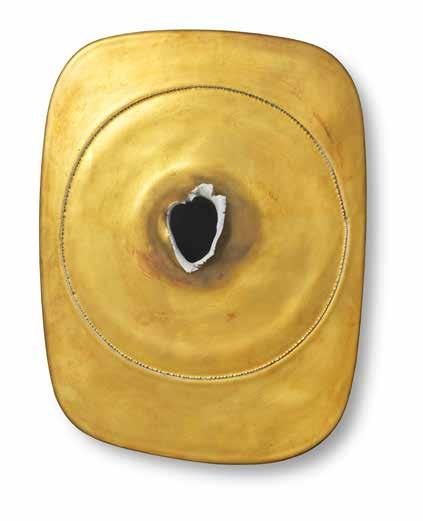
Fontana faced a surprise of his own, when he returned to Milan and found that his studio on via Boccaccio had been destroyed by Allied bombing during the Second World War. He was now approaching 50 and hardly accorded a hero’s welcome: at the time, he was probably best known for a handful of works he had created in the 1930s.
Undeterred, Fontana went on, over the course of the next two decades, to revolutionise painting as people knew it. “I am an explorer,” he said shortly before his death in 1968, looking back on his post-war innovations. “Art was no longer to be thought of in terms of brushes and painting… and canvases and frescoes.”
Broadly speaking, Fontana’s revolutionary move consisted of rupturing the picture surface in varied ways. Six works by him from the 1950s and 1960s will feature in the sale, 20th Century Masters: A Private Collection –Kandinsky and Fontana to Baselitz, all of them appearing
at auction for the first time, all from the same private collection, and all unseen in public for half a century.
Born in the Argentinian city of Rosario in 1899 to parents of Italian stock, Fontana was exposed to art from an early age. His grandfather had been a painter, and his father a sculptor who specialised in funerary monuments for a bourgeois Catholic clientele.
As a boy, Lucio was sent to school in Italy. He went on to volunteer for the Italian army in the First World War. Little is known about Fontana’s experiences at the front –except that he served in the infantry and was invalided out of action in 1918, after being wounded badly in the arm.
Soon he was back in Argentina: at first joining his father in the family business, then opening a sculpture studio
26 | Bonhams Magazine
“Fontana faced a surprise of his own when he returned to Milan. His studio had been destroyed by Allied bombing”
Left Cut above the rest, Lucio Fontana at his desk

of his own. Fontana is often considered purely through a European prism. However, we shouldn’t overlook the influence of the country of his birth. He certainly didn’t.
Late in life, for example, having gained renown for coming up with a new concept of pictorial space (much more on which below), he was asked by an American critic: “How can you, as an Italian, understand space? We’ve got Arizona – there’s space for you.” Fontana replied, “I am Argentinian, and we have the Pampas, which is ten times larger, sir, than Arizona’s deserts.”
In 1927, he returned to Italy, studying at Milan’s Brera Academy of Fine Arts. Now his art career began in earnest – though, in the run-up to the Second World War, one might actually say that he had two careers.
Fontana took up several commissions to produce sculpture for the fascist regime, perhaps the most famous being the striding female figure of Victory, an impressive six metres tall and guiding a pair of rampant horses. Displayed at the Milan Triennial of 1936, it glorified the recent imperial conquest of Ethiopia by Italian forces.
Simultaneous with such public offerings, Fontana made private works, which tended to be more avantgarde in style. Notable were a host of semi-abstract ceramic objects, which look rather like sketches in clay.
These expressive pieces – whose subject matter ranges from battle scenes to flowers – gain an immediacy
from Fontana’s vigorous hand-modelling. The artist himself referred to them as “motionless earthquakes”.
After the Second World War broke out, Fontana returned to Argentina: partly due to the pleas of his father, partly to avoid another bout of military service.
Settling in Buenos Aires, he co-founded the Altamira Academy, where debates with his students culminated in the publication of the so-called WhiteManifestoof 1946. Like the Firstand SecondManifestosofSpatialism
that followed it, this was filled with numerous overblown passages, but the gist of these texts was important, echoing the Italian Futurists’ position from earlier in the century. Put simply, Fontana advocated an end to the painting of pretty pictures in favour of exploring the dynamic concepts of movement, time and space.
Fontana’s particular exploration entailed attacking what he regarded as the prison of the flat pictorial surface. Back in Italy after the war, he began series such as Buchi
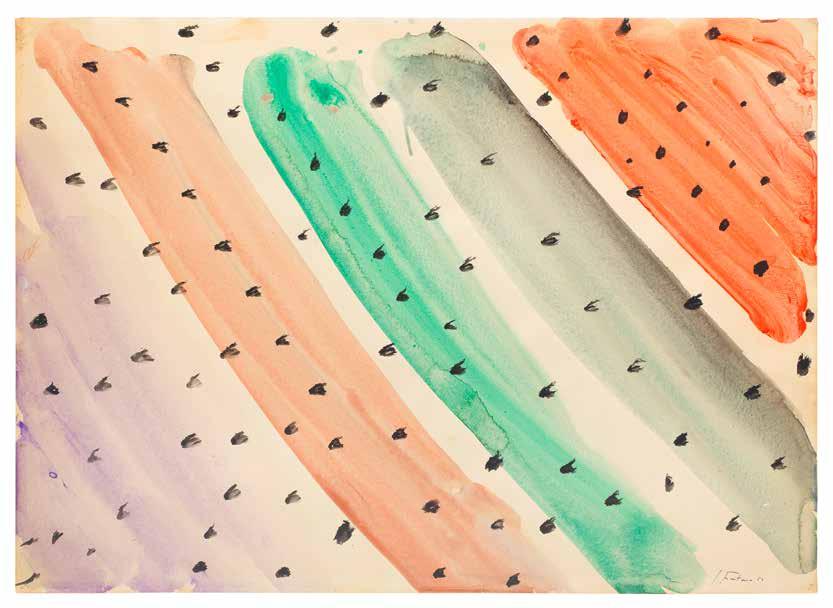
| Bonhams Magazine 28
“People think it’s easy to make a cut or a hole. But it’s not true. You have no idea how much stuff I throw away”
Below
Critics nicknamed Fontana ‘Lucio the Ripper’, although the placement of his slashes was carefully considered
Right
Concetto Spaziale (1952) is an early example of Fontana's Buchi series, where holes were punched through the canvas
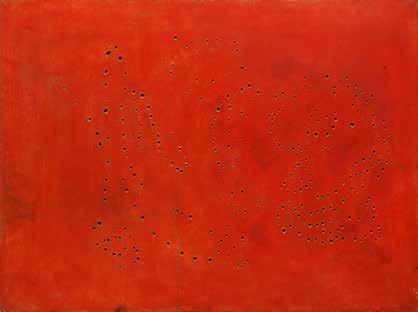
Below right
The Fontana ceramic Concetto Spaziale (1960-1963), sold at Bonhams in 2015 for £110,000

Opposite Lucio Fontana (1899-1968)
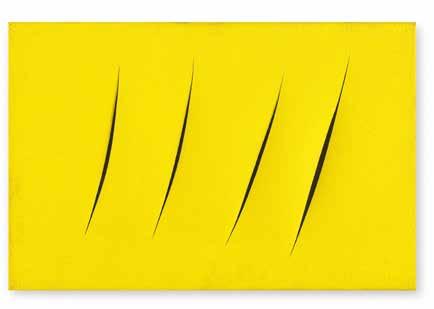
Concetto Spaziale, 1951 watercolour on paper 50 x 70cm (19¾ x 27½in)
Estimate: £30,000 - 50,000 ($40,000 - 60,000)
(which translates as ‘Holes’, 1949-1968), in which he punched holes through canvases with the bottom of his brush, and Tagli (‘Cuts’, 1958-1968), canvases slashed with a Stanley knife.
It’s the latter for which he is best remembered today and which earned him the nickname ‘Lucio the Ripper’. He produced more than 1,500 Tagliin total, the variety between them coming chiefly in the form of Fontana’s choice of colour (the canvases were monochromatic), as well as the number, angle, size and distribution of slashes.
The top lot of the upcoming sale, ConcettoSpaziale, Attesefrom 1959, stands out for the unusually high number of cuts (14) and the equally rare use of a unusually shaped canvas (as opposed to a rectangle).
The sale includes three other Tagli– two from 1960, another from 1966 – all four bearing the same title. There’s a noticeable shift from the freer, more experimental slashes on the earliest canvas to the more precise, more controlled slashes on the final one.
The great paradox of the Tagliis that a seeming act of violence resulted in works of great beauty. The ostensibly destructive ended up gloriously creative.
“To write poetry after Auschwitz is barbarism,” the philosopher Theodor Adorno famously claimed, doubting if art could ever have meaning again after the horrors of the Holocaust. With his Tagli, Fontana managed to reflect the trauma of recent history (the dropping of the atomic
bomb on Hiroshima and Nagasaki included), yet produce a triumph of artistic expression at the same time.
It has been suggested Fontana was more interested in the concept behind his works than in their execution. However, he gave the lie to this view himself: “People think it’s easy to make a cut or a hole. But it’s not true. You have no idea how much stuff I throw away.” These aren’t the words of someone without an artistic sensibility or a perfectionist streak. There’s a stunningly simple elegance to the Taglithat recalls the output of Gucci or Prada, the fashion houses that came to flourish in the same era.
Bonhams Magazine | 29 20TH CENTURY MASTERS
Fontana made his cuts while the paint was still slightly wet, moulding their shapes by hand when it was dry, and applying a black gauze behind the canvas to give an impression of measureless depth. The Tagliare sculptures as much as they are paintings. What’s more, by opening up a dark void at the heart of his imagery for viewers to contemplate, Fontana expanded into a fourth dimension, folding time and space into one.
The Taglihave been interpreted in myriad ways: from the erotic (evoking female genitalia) to the religious (evoking the stigmata of Christ). Their very openness to different interpretations is key to their success.
Left
Concetto spaziale, Attese, 1959 waterpaint on canvas
81 x 100cm (31⅞ x 39⅜in)
Estimate: £1,600,000 - 2,200,000 ($2,100,000 - 2,900,000)
Below left
Concetto Spaziale, Attese, 1966 waterpaint on canvas
53.8 x 65cm (21¼ x 25½in)
Estimate: £500,000 - 700,000 ($600,000 - 900,000)
Right
Concetto Spaziale, Attese, 1960 waterpaint on canvas
100 x 80cm (39¼ by 31½in)
Estimate: £450,000 - 650,000 ($600,000 - 800,000)
So well known did they become that Fontana was regularly ridiculed by Italian cartoonists – depicting fishermen hurrying out to sea at the sight of him, for example, scared that he might puncture their boats.
Fontana never saw the funny side, calling those who mocked him “imbeciles”, but he would have the last laugh. No museum collection of post-war art is complete without one of his Spatialist works.
By Spatialist, he meant any piece in which he played with the viewer’s appraisal of space. These included his ‘Spatial Environments’, walk-through rooms and corridors with carefully controlled lighting, anticipating the immersive installations so popular today. This also included works such as ConcettoSpaziale,Cratere, which is part of the upcoming auction: a thin piece of porcelain, painted gold, with a hole pierced through it.
Fontana viewed his artistic practice holistically, and was never one to consider himself a sculptor or a ceramicist more than a painter, for example. (“These terms are not for me,” he said).
In his monograph on Fontana, Italian critic Edoardo Persico wrote of the artist’s “ease at subjugating all styles”, as well as his “ability to convert himself continually”. In other words, Lucio Fontana was a cut above the rest.
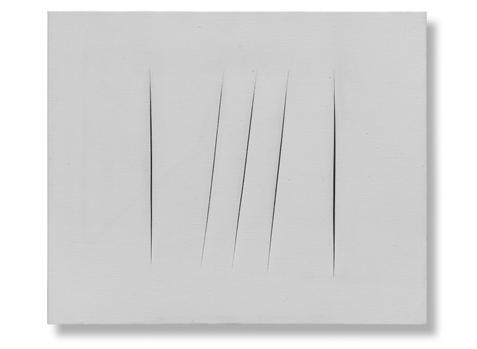

Alastair Smart is a freelance writer.
Sale: 20th Century Masters: A Private Collection –Kandinsky and Fontana to Baselitz
London
Thursday 29 June
Enquiries: Giacomo Balsamo +44 (0) 20 7468 5837 giacomo.balsamo@bonhams.com
| Bonhams Magazine 30
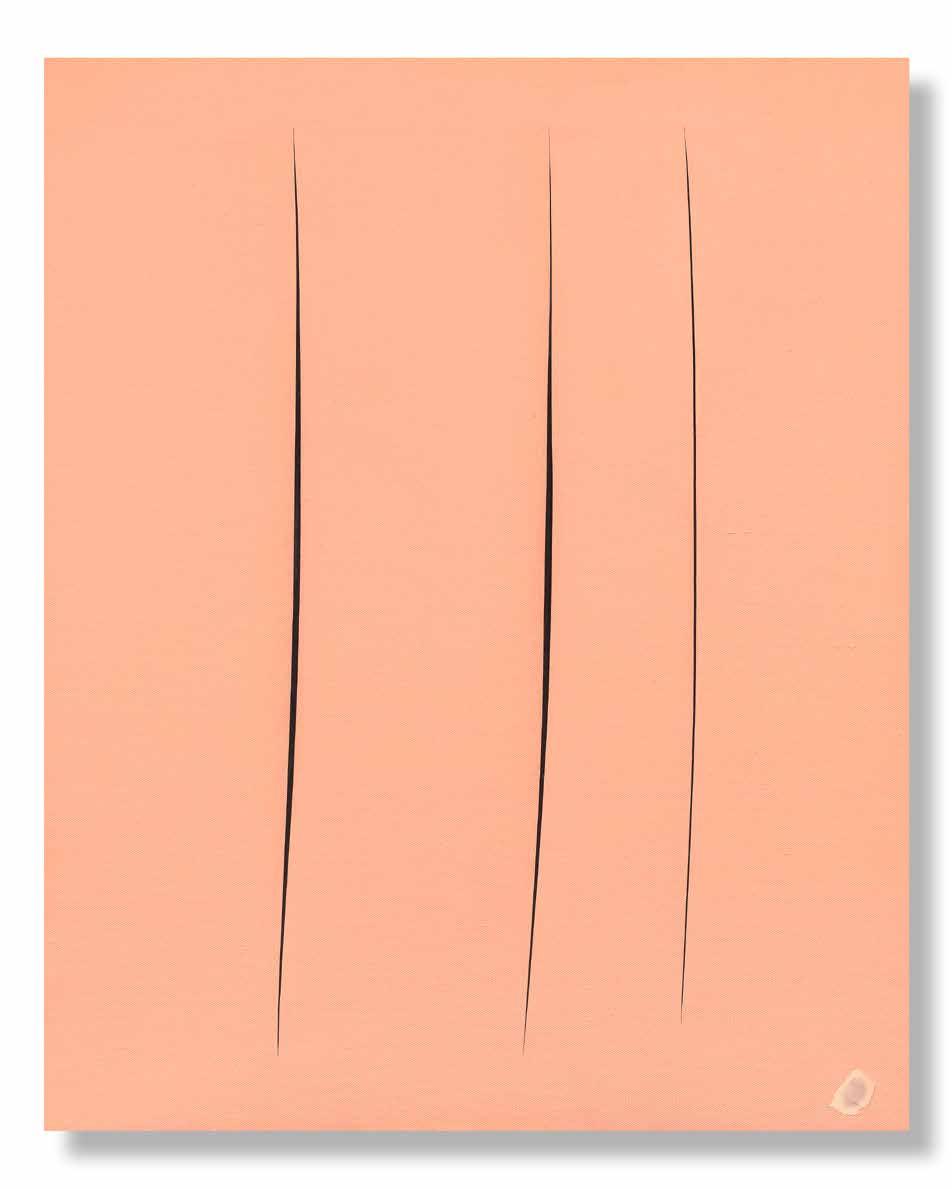
Fast lane
Peter Sellers was a comedy genius and movie star with prodigious passions – for women… and then there were the cars, says Neil Lyndon


Cut to the chase
Getaway cars sold by Bonhams
Citroën DS19 Prestige Saloon 1967
One of the loveliest-ever cars featured in a real-life drama in 1962. President Charles de Gaulle and his wife were being chauffeured to Orly airport when their Citroën DS19 was hit by 140 bullets. They survived thanks to Citroën’s legendary air-suspension system.

Jaguar Mark II 3.8-litre Sports Saloon 1965

In The Sweeney, the classic 1970s TV police series, the Flying Squad drove Fords –but the criminals’ getaway car was often a Mark II Jag, which has a top speed of 125mph. The rozzers didn’t stand a chance.
Peter Sellers bought a car more often than he assumed a different character for a film or married a new wife. In the first year that he started making real money in the 1950s, he manically bought and sold no fewer than four cars. However, Britain’s greatest comic genius since Charlie Chaplin never owned a more desirable car than the 1961 Aston Martin DB4 GT that Bonhams will be offering at this year’s Festival of Speed sale at Goodwood in July. The DB4, introduced in 1958, was one of the key cultural signifiers of its age. Along with the advent of CND, rock ’n’ roll and winklepicker shoes, it announced to the world that Britain was shedding its dour, regimented wartime identity and launching into a thrilling unknown. Until they saw the DB4, designed by coachbuilders Touring of Milan, nobody knew that stodgy, frigid old Britain was capable of such things.
Austin/Morris Mini Cooper ‘S’ Rally Car 1963

No Mini Cooper S is more renowned than the trio that raced through the streets and shopping arcades of Turin, laden with gold, in The Italian Job. As memorable as Michael Caine’s “bloody doors off” line.
Ford Mustang GT 390 Fastback Coupé 1967
Not so much getaway car as don’t-let-’em-getaway car: the Mustang GT Fastback was gunned thrillingly through the streets of San Francisco in pursuit of baddies by Steve McQueen in Bullitt

Hand-built at a new factory in Newport Pagnell, with aluminium-alloy panels that were laid over a lattice-frame of small-diameter steel tubes, the DB4 was delicate without seeming fragile, pretty but masculine. It was Britain’s own Ferrari.

The DB4 GT, introduced in September 1959, was a special lightweight, high-performance version of the DB4. It featured enclosed headlights and a thinner aluminium skin to reduce the vehicle’s weight. The wheelbase was also reduced in comparison to the standard DB4, which resulted in most GTs not being fitted with rear seats. With a top speed of 151mph and 0-60 mph in 6.1 seconds it was at the time the world’s fastest road-legal production car.
Under registration number 41 DPX, the car – which is offered by Bonhams – was acquired from the original owners in late 1961 or ’62 to become the getaway car,
Bruce Reynolds was the brains behind the 1963 Great Train Robbery, which netted £3m in used banknotes. He used his Mk1 Lotus Cortina to scope out the Hertfordshire countryside.


driven by Sellers, in the forgettable British crime comedy TheWrongArmoftheLaw , where it was pursued by a hopelessly outgunned Wolseley 6/90 in police garb. (Character actor Lionel Jefferies occupied the DB4GT’s rare back seats during the film’s climactic chase.)
During filming, the engine block was damaged and was replaced at the Aston Martin factory with a larger 4.0-litre block, fitted in early 1963. According to Aston Martin’s own records, it is to date the only factoryfitted 4.0-litre DB4GT engine. Meanwhile, it was another DB4 that performed the film’s most famous stunt – a flying jump over a bridge. Because the scenes
The ostensible star of the Fast & Furious franchise may have been Paul Walker, but his car was the standout attraction. Anyone who knew cars rated his Nissan Skyline R34 GT-R above all others – it was recently sold by Bonhams for $1.36 million.

were not filmed in sequence, so 41 DPX was back in the spotlight again for the final act.
We know that Sellers was certainly the car’s owner by 1964, but whether he bought it directly off the film lot and how long he kept it, we don’t know for sure.

We can only be certain that whatever answers Sellers himself might have given to these questions would have been unreliable – because this was a man who couldn’t be depended on to tell the truth if you asked him the time of day.
For instance, in a BBC television interview in Hollywood in 1970, Sellers said, “I was born in Yorkshire.” If they had known about that claim, it might later have perplexed the people at English Heritage who were going to put up a blue plaque on a house in Castle Road, Southsea, that declares, ‘Peter Sellers 1925-1980 Actor and Comedian was born here’. Firm evidence suggests English Heritage was right, not least the fact that, two weeks after his birth, Sellers was carried on stage by a friend of his parents in Southsea.
Why would he not tell the truth about his place of birth? Because this chameleon character was capable of saying and believing anything that came into his head, as if he didn’t actually know the difference between truth and fiction. At one point, he claimed to be descended from Disraeli. Perhaps it sounded good to him at the time.
Neither could he tell the difference between his own personality and the role he was assuming for stage or film. “I’ve no idea who Peter Sellers is,” he would say, “except that he’s the one who gets paid.” Once, when he was recognised in the street and asked if he was Peter Sellers, he answered, “Not today.” Stanley Kubrick, who directed him in Lolitaand DrStrangelovesaid, “There’s no such person as Peter Sellers.” When he was making Strangelove, he entered so completely into the character of one of his roles
Bonhams Magazine | 35 GOODWOOD FESTIVAL OF SPEED
Shelby Mustang GT500 ‘Eleanor’ 1967
Racing driver Carroll Shelby produced Ford Mustang muscle cars through the 1960s, but the GT500 was most coveted – not least for its 40-minute chase in 1974’s Gone in 60 Seconds.
Ford Lotus Cortina Mk1 Sports Saloon 1966
Nissan Skyline R34 GT-R 2000
“Peter Sellers bought a car more often than he married a new wife”
© Getty Images
– President Merkin Muffley – that his own long-term secretary didn’t recognise him when they passed each other backstage.
His was far from a comfortable state of mind. The film critic Alexander Walker, who knew Sellers for decades and wrote his biography, said, straightforwardly, that he was mad. The producer Roy Boulting said that Sellers, “Lives half his life in hell.” For his four wives, however, hell was more like a permanent abode. Sellers’ second wife, Britt Ekland (whom he married in 1963, within three weeks of their first meeting and around the time he acquired the DB4 GT) stated on the record that Sellers was bipolar, unstable, brittle and dependent on both cocaine and alcohol. She said he would kick off a titanic row every Friday, which would go on all weekend, including threats of divorce, and then, come Monday, he would bring her a present or take her out to lunch to make up.
He demanded complete control of her life, dictating what she wore and what she said, imposing
a fixed identity on her when he had no certainty about his own. Nightmare.
He was utterly bonkers about women. When he was making TheMillionairess, he became so besotted with his co-star Sophia Loren that he abandoned his first wife and their two children. “Don’t you love us any longer, daddy?” asked one of the children. “Of course I do, darling,” he answered, “just not as much as Sophia Loren.” There is no evidence at all, however, that Loren either reciprocated his feelings or consummated the relationship. It was all in his head.
Sellers’s incessant changing of cars looks as if it was a reflection of his personal insecurities. He explained it by saying that he was looking for perfection. It’s probably closer to the truth to say that he was looking for himself.
As the 1960s developed, Sellers wanted to shed the bespectacled bank-manager look that had seen him through the ’50s. He wanted to make himself hip. So he lost four stones in weight, from 15 to 11 stone, and started wearing kaftans when he went out with his third wife, the hippy chick Miranda Quarry. It wasn’t an entirely convincing transformation. Boulting said, “Inside the new thin Peter Sellers is a fat boy struggling to get out.” When he turned up at the Apple Studios and found the Beatles there, all blithering druggily, he was filmed desperately trying to get down with the kids, wearing a panicked grin on his face and asking, “What exactly are we discussing here?”. Meet Dylan’s Mr Jones.
At the same time, Sellers’s instabilities and

| Bonhams Magazine 36
“Once, he was recognised in the street and asked if he was Peter Sellers.
‘Not today,’ he answered”
© Getty Images
This page
Sellers’
uncertainties gave him a genius for all the dramatic arts. Performance, mimicry and simulation were second nature to a man who had no secure persona of his own, and it was this that allowed him to make authentic masterpieces like Strangeloveand BeingThere
In the DB4 GT, he found an authentic masterpiece to match his own talents. It wouldn’t have made him happy, however. Nothing ever did, or could.
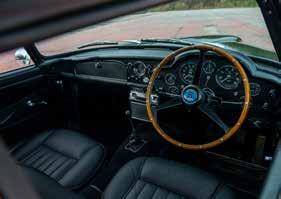



Neil Lyndon is a writer and journalist.
Sale: Festival of Speed Goodwood
Friday 14 July at 11am
Enquiries: James Knight +44 (0) 20 3988 6306 james.knight@bonhams.com
own getaway car: the 1961 Aston Martin DB4 GT, offered at Goodwood Festival of Speed this July, was Britain’s riposte to the best of Italian automotive design
Left Motor mad: Peter Sellers at the wheel of his Ferrari 275 GTB, c.1965 – just one of his prized cars from an ever-evolving collection

Opposite Zeng Fanzhi (b.1964)
Mask 2000 No.3
2000 signed and dated 2000 on the lower right oil on canvas
180 x 150cm (70⅞ x 59⅛in)
Estimate: HK$15,000,000 - 25,000,000 (£1,500,000 - 2,500,000)
Family business
Manfred Schoeni was one of the first people to recognise the brilliance of Chinese contemporary painting. It was love at first sight, his daughter tells Emma Crichton-Miller
In 2004, just as she was preparing for her final exams at the School of Oriental and African Studies in London, Nicole Schoeni heard the news that her father had died. Born in Switzerland, Manfred Schoeni was a successful entrepreneur across many different businesses and the founder of the renowned Hong Kong Schoeni Art Gallery. When he died, he was just 58. Nicole was 23. She flew home to Hong Kong and, even in the midst of her grief, with the support of her mother Wai Yin, immediately took over running the gallery.

Over the previous decade, Manfred Schoeni had brought to light many of the leading figures of an outstanding generation of contemporary Chinese artists. These included now significant names, such as Yue Minjun, Liu Xiaodong, Zhang Xiaogang, Yang Shaobin and Zeng Fanzhi. Manfred had discovered these avant-garde artists while travelling for his antiques business to the Chinese mainland. Most worked under the official radar in the Yuanmingyuan artists’ village, north-west of Beijing
Manfred wrote later, on the eve of the 1994 twoman show Faces Behind the Bamboo Curtain that he
curated, “It was a pure chance that I met Yang Shaobin and Yue Minjun… Instantly, when I saw their painting, my inner feelings and passion started once again to get the better of logical thought.” However illogical it seemed at the time, by 2004 these artists were beginning to achieve fame and fortune. Yue’s strand of Cynical Realism, with his exaggerated laughing man self-portraits, caught the world’s attention at the 48th
Venice Biennale in 1999, opening the international art market to him. In 2007, just three years after Manfred’s death, Yue’s satirical masterpiece TheExecution (1995) became the most-valuable work by a Chinese contemporary artist at auction when it sold in London for £2.9 million.
For nine years, Nicole Schoeni ran her father’s gallery at full pelt. She mounted 16 exhibitions a year,

Bonhams Magazine | 39 HONG KONG
“When I saw their painting, my passion got the better of logical thought”
Left & above Nicole Schoeni and her father Manfred: “Dad was buying entire collections from the artists, so that they wouldn’t have to worry about income. They could create and Dad would bear all the risk”
Image credit: Nick Smith Photos
navigated the exploding market for some among her father’s stable of artists, while seeking out the next generation of emerging artists – including a focus on the challenging, nascent market for Hong Kong artists and urban art. In 2013, she took a break, redirecting her energies into curation and art consultancy. In May, Bonhams Hong Kong is offering 15 works that the family has retained over many years. The sale, REdiscovery:ManfredSchoeni’sLegacy , takes place almost 20 years after Nicole’s father’s death, and ten years since the closure of his gallery, as a gesture of homage to Manfred. The small collection includes work by perhaps the most successful of all her father’s protégés: Zeng Fanzhi (b. 1964). His famous Mask Series 1996No.6, a large oil-on-canvas diptych of youths wearing exaggerated smiling masks and red scarves, auctioned for more than HK$70 million ($9 million) in 2008 and HK$105 million in 2017, before selling for an artist record of ¥161 million ($23.3 million) in Beijing in 2020. His works here also feature masked figures in Western dress, ambivalently embracing Western lifestyles. Other artists represented in the sale include Yue Minjun, Yang Shaobin, Liu Wei and Liu Xiaodong.
Nicole says, “It has been hard to let these go.” As she points out, at the time he died, her father had not yet seen the market frenzy for Chinese contemporary art, which really took hold from 2006. No, Manfred had supported these artists out of passion. From a poor background himself, he had been guided away from his interest in art to study hotel management. This, and a strong appetite for risk, had brought him to Hong Kong where he built several businesses – including hotels,
Left Liu Xiaodong (b. 1963)

Lovers 1991 signed and dated on the upper left oil on canvas 100 x 73cm (39⅜ x 28¾in)
Estimate: HK$2,500,000 - 4,500,000 (£250,000 - 450,000)
Below Lui Wei (b.1965) You Like Me, Why Not? Series No.33
1996 signed and dated on the lower left oil on canvas with nails 30 x 40cm (11⅞ x 15¾in)
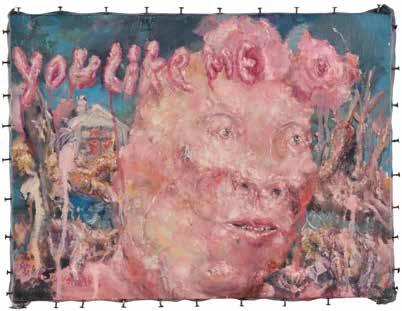
Estimate: HK$500,000 - 800,000 (£50,000 - 80,000)
restaurants, factories and an antiques gallery. He was, however, an enthusiastic self-taught painter, and as soon as he met these artists he recognised the significance of their efforts. He immediately recognised how their work registered the seismic changes in Chinese society brought about by Deng Xiaoping’s 1978 Open Door Policy, especially as those changes had brought these children of Mao’s Cultural Revolution into rapid conflict with a still monolithic authoritarian state. In an interview for LATITUDE/ATTITUDEin 2012, an exhibition
celebrating the 20th anniversary of the Schoeni Gallery, Zeng Fanzhi recalled: “Actually, there were only two people in [Hong Kong] who were interested in Chinese art in early ’90s: one is Johnson [Chang, of Hanart TZ] and the other is Nicole’s father [Manfred Schoeni].”
Although he spoke no Mandarin, Manfred impressed the artists with his generosity and integrity. He would arrive with cash, artists’ materials and books about contemporary Western art – all hard to come by in 1990s China. His flamboyant love of life – especially wine and cigars – charmed them. At first, he had no space. Indeed, in November 1992 his first show, of work by Liu Dahong, was held at the China Club, Sir David
| Bonhams Magazine 40
“Nicole ran her father’s gallery at full pelt… navigating an exploding market, seeking out the next generation of emerging artists”
Right Zeng Fanzhi (b. 1964)
Class One Series No.2
1996
48 x 38cm (18⅞ x 15in)
Estimate: HK$1,200,000 - 2,000,000
(£120,000 - 200,000)
Tang’s chic Hong Kong restaurant, almost entirely furnished with antiques provided by Schoeni. By March 1993, Manfred had secured a gallery space and began a rolling programme of exhibitions accompanied by substantial catalogues, many written by leading scholars in the field, such as Li Xianting, James Cahill and Tsao Hsingyuan. Nicole says, “Something unique about Dad was that he was buying entire collections from the artists, so that they wouldn’t have to worry about income. They could continue to create and Dad would bear all the risk.” In a particularly spectacular demonstration of faith in his artists, in 1997 he organised an exhibition of 15 artists called 8+8-1, for which he commissioned more than 700 small-scale works. Most did not sell. Nicole says, “It was only later that those artists really became sought after.” He was also instrumental in enabling two major exhibitions: China!, in Bonn, in 1996, and (in collaboration with curator Walter Smerling) Chinart, an exhibition of many Chinese Contemporary Artists which toured five European locations between 2003 and 2005.
Gradually, through his efforts and those of Johnson Chang, news got out. Western collectors, spearheaded by Swiss banker Uli Sign, began to recognise the significance of this generation of artists. The boom among Western collectors in the mid-2000s was quickly succeeded by the growing enthusiasm for these artists among Chinese collectors. By 2013, however, Nicole was becoming disillusioned. Many of the most successful artists had naturally moved to bigger international galleries. The urgent radicalism of the art of the 1990s, with its creative collisions between Western and Chinese artistic traditions, gave way to more crowd-pleasing imitations, and collectors seemed increasingly focused on investment potential rather than on whether or not they cared for the art. Nicole says that, while her father was an astute businessman, “he had an

instinct and a very keen eye and just a love of art.” She treasures some notes she found, where he had written: “Art is often presented in a form fitting the experts and critics. Art should be free from any preconceived analysis by others, because art should speak its own language.” Manfred’s collection reflected his own eclectic taste. With this sale, Nicole is relaunching the collection in a similar spirit. “I am more experienced and mature now, and understand that there should be an evolution.” The proceeds from the sale will enable her to pursue her own collecting passions, as well as support her new venture Schoeni Projects, launched in London in 2020 as a platform for emerging artists in both Asia and the West.
Sale: REdiscovery: Manfred Schoeni’s Legacy
Hong Kong
Saturday 27 May
Enquiries: Marcello Kwan +852 2245 3717 marcello.kwan@bonhams.com

Bonhams Magazine | 41 HONG KONG
Emma Crichton-Miller writes for Apollo Magazine
Above Nicole Schoeni ran her late father’s gallery at full pelt for nearly a decade
Image credit: Tai Chi Chueng
The eyes have it
Alain Delon had it all – stunning looks, starring film roles, beautiful women. He also has an enduring love for the greatest fine art. Alexandre Crochet admires Delon’s superb collection

Raoul Dufy (1877-1953)
La baie de Sainte-Adresse, 1906 signed and dated ‘Raoul Dufy 1906’ (lower right) oil on canvas
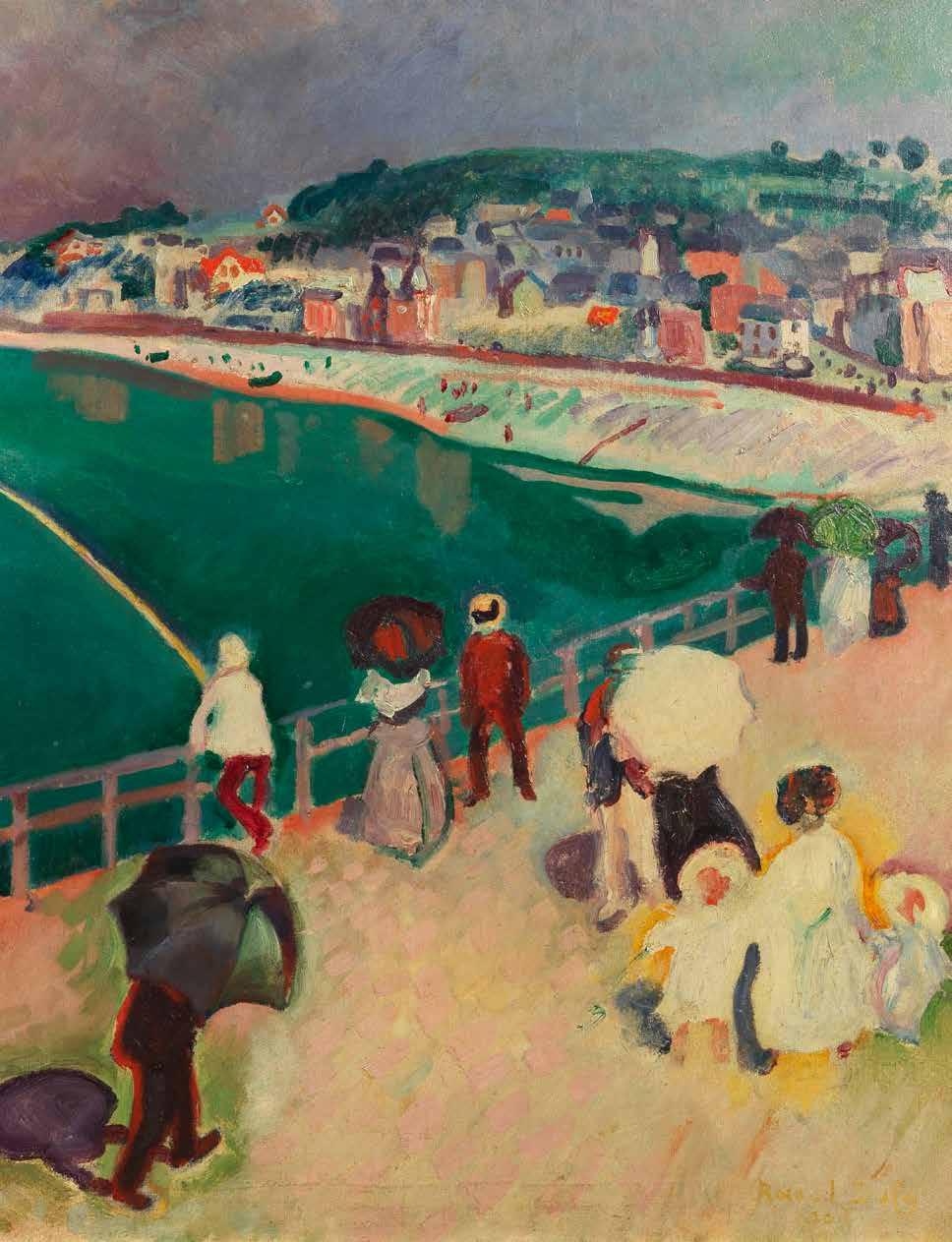
65 x 81.3cm (25½ x 32in)
Estimate: €600,000 - 800,000 (£500,000 - 700,000)
He has worked with the greatest film directors and held the most beautiful women in his arms. But he has also gazed, face to face, at drawings, sculpture and paintings that he alone has chosen. The collection of art that Alain Delon has patiently assembled over nearly 60 years is the expression of his own vision –with, at most, assistance from just a few specialists who would go on to become his friends. Now, in Paris in June, he will part with it.
This particular production by Delon features an all-star cast: Delacroix, Géricault and Millet, and also Guercino, Beccafumi and Veronese. And Raoul Dufy is on camera too, with his gem of a painting LaBaie deSainte-Adresse

Delon’s collection has never been about speculation –nor did he have any desire to be ‘fashionable’, to concern himself with those up-and-coming contemporary artists that he could easily have bought at the opportune moment. No: as in everything he has done in his life, the actor simply followed his instincts and personal tastes – in short, he was guided by his own individual
personality. And, with the benefit of hindsight, his choices have turned out to be very sound.

As soon as he became successful – that is to say, very early in his life – Alain Delon began collecting. Even as a child in the suburbs of Paris, people turned to look when he walked by. While Delon was still a teenager, he joined the French navy to get away from his family, and he spent several years fighting in Indochina. When he returned, beneath his youthful features, he was already a man.
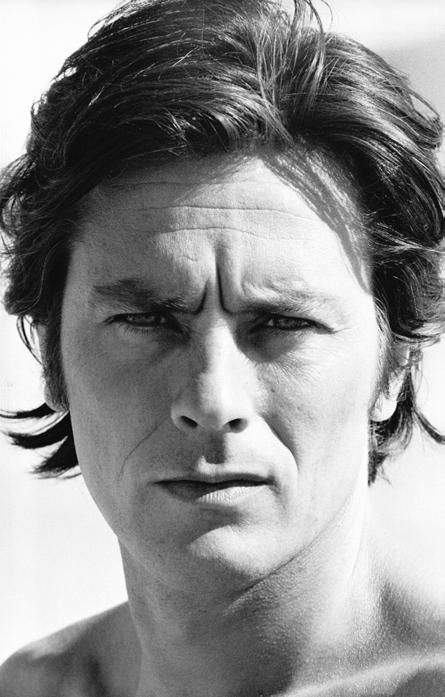
In 1957, Delon was 22 years old and happened to be in Cannes, on the French Riviera. There a talent scout for 20th Century Fox, struck by his good looks, offered him a contract in Hollywood. But the young man, who knew nothing about acting, hesitated. And so his destiny was sealed: ultimately it would be from Paris that he conquered the world.
Fortuitous encounters with a number of women helped him during his early forays in the world of film. During the shooting of his third film, Christine, he fell for his co-star Romy Schneider, Delon’s first great love, whom he pursued with charm and characteristic
| Bonhams Magazine 44
Left Alain Delon, photographed in 1972 by Jean-Pierre Bonnotte
Above Véronèse (1528-1588) Saint Georges terrassant le dragon pen and brown ink, laid down on an English 18th-century mount 8.7 x 5.2cm (3½x 2in)
Estimate: €40,000 - 60,000 (£35,000 - 50,000)
© Jean-Pierre Bonnotte / Gamma Rapho
determination. The latter also came to the fore when Delon had to fight with the producers to land the title role in PleinSoleil, René Clément’s adaptation of Patricia Highsmith’s novel TheTalentedMrRipley . His sensual interpretation, with his character being the
Left
Delon and Romy Schneider –co-stars in La Piscine (1969)

Above Alain Delon with Ursula Andress in Red Sun (1971)

Below left Georges-Lucien Guyot (1885-1973)
Lion couvrant une lionne bronze 62.5 x 108.5cm (24½ x 42¾in)

Estimate: €30,000 - 40,000 (£25,000 - 35,000)
epitome of duplicity, was Delon’s breakthrough role. After that, the actor went on to appear in a string of masterpieces, proving that his talent went beyond his astonishing beauty.
The Sixties, a Golden Age for film, saw him scale the heights of the cinematic art, starring in Rocco andHisBrothersand TheLeopard– both directed by Visconti – and Antonioni’s TheEclipse, as well
as Clément’s LesFélins(alongside Jane Fonda), AnyNumberCanWinby Henri Verneuil and, above all, LeSamouraï, a chilling thriller directed by Jean-Pierre Melville. And then there was LaPiscine, by Jacques Deray, another film noir, but this time shot under the blazing sun of the French Riviera and co-starring Romy Schneider. In the following decade, Delon continued to excel, taking lead roles in Melville’s LeCercleRouge and Deray’s Borsalino&Co., among many others.
From South America to Japan, Delon was recognised as a star – and his stellar qualities still shine. As late as 1986, British indie pioneers The Smiths were putting his photograph on an album cover, while in 2012 Madonna released a song called ‘Beautiful Killer’ that was inspired by Delon’s performance in LeSamouraï. And just a few years ago, to advertise its perfume Eau Sauvage, Dior reached for the timeless image of this 1960s icon as the symbol of a mythical bygone era.
All this while, Delon has been buying works of art. It became an all-consuming private passion, which he pursued with the same intensity that he showed in Molinaro’s film ManinaHurry , where he virtually
Bonhams Magazine | 45 ALAIN DELON COLLECTION
©
“Alain Delon has worked with the greatest film directors and held the most beautiful women in his arms”
© Alamy
Alamy
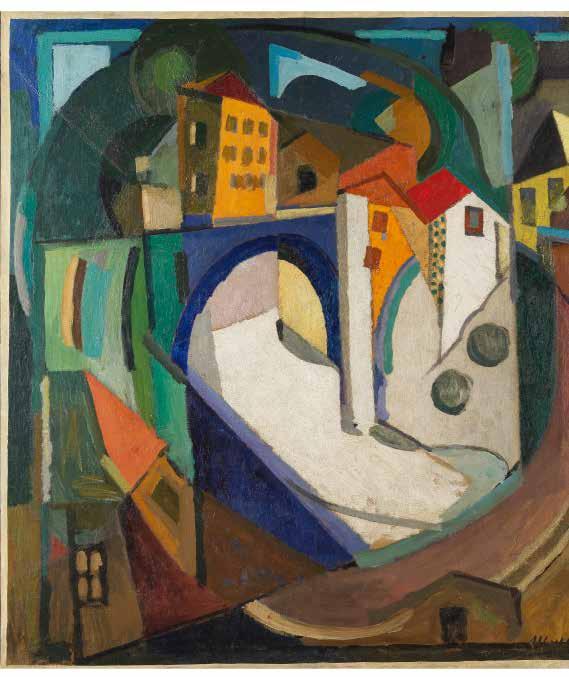
| Bonhams Magazine 46
Albert Gleizes (1881-1953)
Paysage, 1914-15 oil on canvas, signed and dated 102 x 102cm (40in x 40in)
Estimate: €200,000 - 300,000 (£170,000 - 260,000)
plays his double. But he collected with discernment. He became interested in drawings at a time when that market was still undervalued. In 1964, a year after TheLeopard, he bought his first drawing, a sketch by the Neapolitan Baroque artist Micco Spadaro. With his friend, the Parisian auctioneer Pierre Cornette de Saint Cyr, Delon would fly to London almost every week to follow the auctions. He also heeded the advice of dealers Yvonne Tan Bunzl, in London, and Claude Aubry, whose gallery was on rue de Seine in Paris, and who introduced him to 19th-century drawings and paintings.
When Alain Delon wants something, he usually makes sure that he gets it. This was true of his collecting, even when it meant paying what were very high prices at the time. That is how he once acquired a drawing of a beetle by Dürer, after facing off with a banker in a bidding war. He later sold the drawing to the Getty Museum in Los Angeles. “I never had even half of a tenth of what the big bankers bidding at auction had. But I did have one advantage: the will to get what I wanted. I would go over the estimate and then think, ‘How am I going to do this?’
Above Achille-Émile Othon Friesz (1879-1949)
Le port d’Anvers oil on canvas painted in 1906

50 x 61cm (19½ x 24in)
Estimate: €140,000 - 180,000 (£120,000 - 160,000)
Left
Attributed to Jacopo Carrucci (‘il Pontormo’) (1494-1556) or his school

Un amas d’hommes nus allongés black chalk

13.5 x 27.4cm (5¼ x 10¾in)
Estimate: €30,000 - 50,000 (£25,000 - 40,000)
Fortunately, in the 1960s, I was one of the highest-paid actors. I was filming and filming in order to buy them. All my money went into it,” he said in 2010. With Delon, it was about determination, always.
Fascinated by the first sketches made by artists, he acquired a double-sided sheet from the 15th century by Beccafumi, a StGeorgeSlayingtheDragonby Veronese from the following century, and a small ChristontheCrossby Guercino from the 17th century, a treasure acquired in 1972 at the Ellesmere Collection sale in London. In 2010, when Delon’s collection of drawings was exhibited at the Salon du Dessin at the Palais Brongniart in Paris, it revealed his exquisite taste.
“For a long time, I only had sketches, which fascinated me. The artist takes this as the starting point to make the canvas. Then I discovered the Impressionists, the Post-Impressionists, the Fauves…”, the actor recalls. In this, his choices reflect the interests of collectors in the 1960s and 1970s, long before contemporary art was making a name for itself. Unfailingly loyal to his ‘masters’ in cinema, Delon is equally in thrall to master artists.
Bonhams Magazine | 47

Above Paul Serusier (1864-1927)
Le Torrent (1893) screen with four painted leaves 120 x 52cm (47¼ x 20½in)

Estimate: €150,000 - 250,000 (£130,000 - 220,000)
Below Rembrandt Bugatti (1884-1916)
Panthère grognant et feulant, c.1907 bronze with polychrome patina 34 x 61 x 23cm (13⅜ x 24 x 9⅛in)
Estimate: €250,000 - 300,000 (£200,000 - 250,000)
His tastes have changed little, apart from a foray into the lyrical abstraction of the Second School of Paris. In 2007, he sold 40 abstract paintings by artists including Maria Helena Vieira da Silva, Pierre Soulages, Hans Hartung and Jean Dubuffet at Cornette de Saint Cyr (now Bonhams Cornette de Saint Cyr) in Paris.
Now in his eighties, this giant of cinema is parting with 85 of his most beloved works, art that has accompanied him through his daily life for almost 60 years. The last time he revealed the extent of his collection was in Paris in 1990, with an exhibition at the Didier Imbert gallery. Since then, Delon has continued to collect, loaning certain pieces for museum exhibitions.
His love of animals – particularly horses and cats of all sizes – is reflected in some of his favourite works, among them Chevalarabeattachéàunpiquet, a painting by Delacroix, which Delon bought at the Drouot auction house in Paris in 2001. But it is also there in sculptures such as a Chevalturcin bronze by Antoine-Louis Barye, acquired in Paris from the gallery run by François Fabius, one of the great specialist dealers, as well as a series of cats by Georges Guyot and, above all, three pieces signed by Rembrandt Bugatti, including Panthère grognantetfeulant. Delon’s passion for the Italian animal sculptor, sparked by Parisian dealer Alain Lesieutre, inspired him to assemble what is probably the world’s largest collection of work by Bugatti, whose lively style he particularly admires.

Apart from sculpture, Delon’s favourites are still, as he confided to us, Delacroix, Millet and Géricault, whose double-sided study for the famous Raftof the‘Medusa’ , one of the highlights of the Louvre’s
extraordinary collection, should interest museums. But it is perhaps in the dozen works by Jean-François Millet, champion of an authentic rural life, owned by Delon that we get a glimpse of their owner. Delon has amassed a collection of refinement, the very image of its owner – and his collection would undoubtedly be almost impossible to put together today.
Alexandre Crochet is Associate Editor of The Art Newspaper France
Sale: Alain Delon: 60 Years of Passion Paris
Thursday 22 June
Enquiries: Arnaud Cornette de Saint Cyr +33 1 5679 1240 arnaud.csc@bonhams-csc.com
Bonhams Magazine | 49
©
/
Michel Ginfray
GAMMA RAPHO
Left Khakhar used his “awkwardness” to his advantage, underpinning his distinctively ironic style
Opposite Bhupen Khakhar (1934-2003)
Residency Bungalow oil on canvas, framed 130.5 x 122.5cm (51½ x 48¼in)
Estimate: £250,000 - 350,000 ($350,000 - 450,000)

God of small things
He was just an accountant in a “pretty dull” little city, but there Bhupen Khakhar created art so vivid he became one of India’s best-loved painters, says Mark
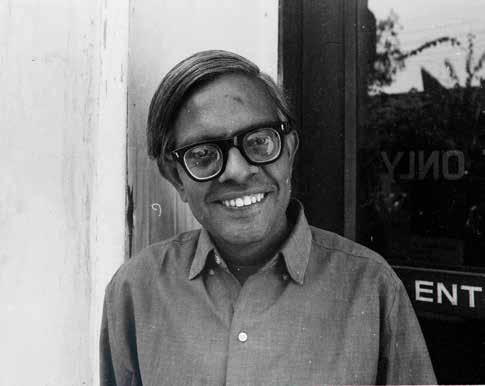
In a self-published booklet accompanying his 1972 exhibition TruthisBeautyandBeautyisGod, the Indian painter Bhupen Khakhar had himself photographed as the kind of urbane man-of-action who was then ubiquitous in international advertising. Sporting dark glasses and a natty Western-style suit and brandishing a toy gun, Khakhar cavorts with a British woman friend in images that provide many insights into this elusive and supremely ambiguous artist.
In real life, Khakhar appeared far from the cosmopolitan he-man: a gay chartered accountant who came to painting relatively late in life, he had a talent for gentle – and sometimes not-so-gentle – selfmockery. Khakhar had a profound understanding of the “awkwardness” he saw as his defining characteristic, a quality which pervades the paintings that have made him one of India’s best-loved contemporary artists.
In its Modern & Contemporary South Asian Art sale in London, Bonhams is offering a painting from a pivotal moment in Khakhar’s early career. Residency Bungalow(1969) shows a colonial-era building in the city of Baroda, where he trained as an artist and spent most of his subsequent life. The Bungalow, where he lived with several other key artists of the period, represented the realisation of his long-held dream of becoming a painter. It is captured in a haunting and deceptively simple image, under the evident influence of traditional Indian miniatures. At the time of its creation, Khakhar
Hudson
was starting to achieve commercial success, and about to embark on the works that made him famous. Yet he was still working part-time as an accountant, taking care of the financial affairs of the owners of the building: the Royal Family of Baroda. It was an arrangement that I’ve no doubt proved very satisfactory to all parties.
Khakhar’s visionary paintings of urban Indian life have been interpreted by some critics – both Indian and Western – as faux-naïf pastiches of traditional miniature painting, but nothing could be further from the truth.
Khakhar’s evocations of people and places are, like those of his close friend Howard Hodgkin, highly sophisticated distillations of memory and observation, realised in transcendent – at times near-hallucinatory – colour. Yet, where Hodgkin sublimated his feelings in semi-abstract compositions, Khakhar made his reactions to his subjects very evident on the surfaces of his paintings, to the discomfiture of many viewers.
Khakhar was born in Mumbai in 1934 to a Hindu family of high caste but modest economic status – which no doubt explains a lot. Precociously able at school, he
| Bonhams Magazine 50
“He was a gay chartered accountant who came to painting late in life”
© Navrose Contractor
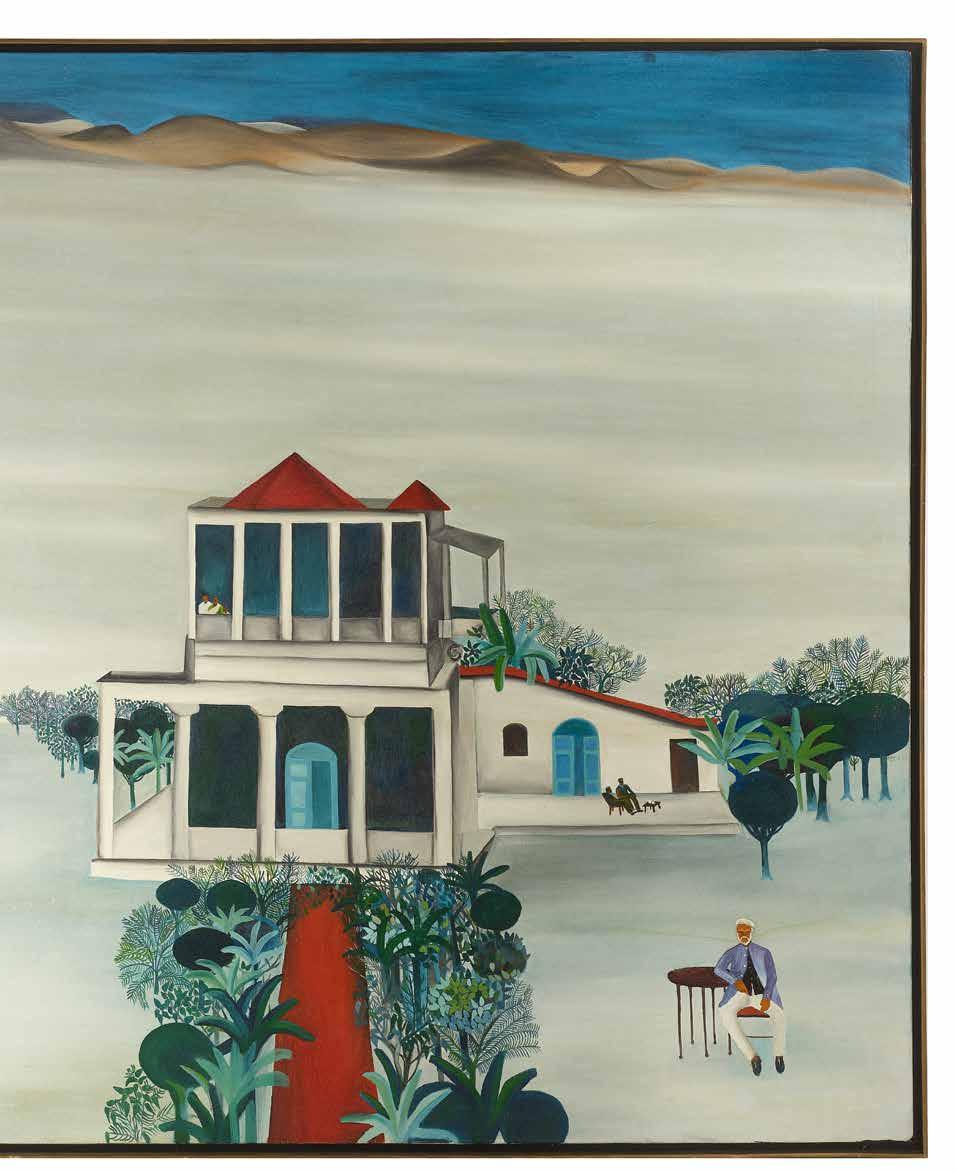
Bonhams Magazine | 51
was the first member of his family to attend university, but after gaining only a third-class degree in Economics and Political Science – to his intense mortification –he switched to accountancy, obtaining “the highest marks in Bombay University in public finance and administration”. This fact is noted in his 1972 booklet with a pride that feels only partly ironic. Khakhar is regarded as a great observer of the status-obsessed mores of India’s urban middle classes, which was precisely the world he himself came from.
Excited by art from an early age, Khakhar began taking evening classes in drawing in his early 20s, though he was unimpressed by the teaching – “they only talked to the girls” – and had the despairing sense that he would never be able to explore his life’s real passion. But around 1960 Khakhar met the young Gujarati poet and painter Gulam Mohammed Sheikh, who was to become his mentor – and it feels somehow typical of Khakhar that his mentor should have been three years his junior.
Sheikh had attended the then recently founded Faculty of Fine Arts in Baroda, an ‘experimental art school’ with a more open approach than the academic Mumbai colleges. Sheikh was now teaching at the Faculty himself, and when Khakhar summoned the courage to show him his portfolio, he suggested he too might benefit from a period of study there. Khakhar jumped at the chance of finally pursuing art full time at the age of 28, and escaping his interfering family who would “never allow me to become an artist”.
Above Khakhar had no formal training in fine art, instead earning a master’s degree in art criticism
Opposite Man in Pub, a painting by Khakhar inspired by his sojourn in England, sold for £263,000 at Bonhams in 2016

Turned down by the fine-art department, he took a master’s degree in art criticism, adding greatly to his knowledge of art history, but compounding his enduring sense that he would never quite be a ‘trained artist’ – an assessment many of his critics were to agree with. After graduating in 1964, he returned to Mumbai, but was soon back in Baroda. “I needed complete freedom,” he later said, and while he often complained that Baroda was “a pretty dull place”, he clearly found it on some levels magically exciting: its backstreets and bazaars filled with the sounds of popular religion and people pursuing their time-honoured trades. This is the atmosphere that permeates his best-known pictures.
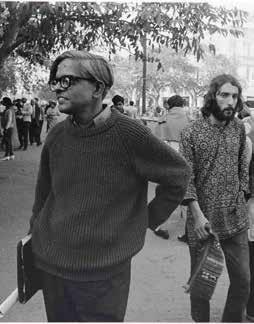
With a population of more than 2 million, Baroda was hardly a small town, but compared with Khakhar’s home metropolis Mumbai it had a quality of provincial ordinariness, plus a large population of artists connected with its Faculty of Fine Arts. It was a combination he clearly found congenial. Apart from a few visits abroad, he remained in Baroda for the rest of his life.
The atmosphere of ResidencyBungalowis serene and otherworldly rather than frenetic, the painting imbued with a dream-like clarity and calm. The jumble of fields and other dwellings that no doubt surrounded the building in real life is stripped away, leaving an ethereal plain that might be interpreted as desert or cloud rolling away towards distant hills and a sky of intense blue. A path of red carpet leads towards the pillared verandah, flanked by beds of minutely detailed shrubbery, giving
| Bonhams Magazine 52
Left Khakhar’s Joe Hope and Mary Hope at Box sold at Bonhams in 2007 for £28,000
© Navrose Contractor
the impression of a blessed domain that exists in its own realm of time and space.
In the right foreground, a white-bearded figure sits at a table in the garden: Khakhar’s close friend and mentor Gulam Mohammed Sheikh, the man who brought him to Baroda and enabled his career as a professional artist. The fact that he looks far older than his 32 years indicates his significance in the artist’s life and his seniority in their relationship.
Further back on the terrace, Sheikh is seen again, drinking tea with the sculptor Nagji Patel, also then resident in the house, while from an upper window K.G. Subramanyan, another dominant figure in the Baroda art scene, looks out with his wife and daughter. Subramanyan devised the Faculty of Fine Art’s ethos of ‘living traditions’, under which contemporary art drew on still-extant traditional forms. At the time of making this painting, Khakhar had been through a Pop Art phase, employing found popular and religious imagery under the influence of British artists Derek Boshier and Jim Donovan, who both taught for a time in Baroda. He was now making his own exploration of the ‘living traditions’ concept, travelling round India and absorbing traditional painting techniques. These efforts come together in ResidencyBungalowin what feels like a stripped-back, contemporary response to traditional miniature painting, with beautifully balanced shades of deep red and blue standing out from the overall cool tonality in an image that feels like a summation of his experience in art to date.
If the vegetation in the painting is rendered in the kind of organic ‘tasteful’ hues, muted greens and browns, that made Khakhar’s paintings of this period appealing to wealthy art buyers, he was soon to decide that “good taste can be very killing”. In his paintings of the early Seventies, he turned up the intensity of his colour in eye-popping combinations of cerise and deep turquoise, orange and ultramarine that reflected the garish neon-
tinged textures of the densely populated urban area where he now lived, but which were considered ‘vulgar’ by his former buyers and admirers.
In the most radical works of this period, Khakhar shows the crowded world of the Baroda backstreets as a stream of chronological events visible in a single image, in a manner that recalls both Hindu ‘pilgrimage chart’ paintings and the works of Quattrocento Sienese painters such as Duccio and Sassetta, of whom Khakhar was a great admirer.
In the most remarkable of them, YouCan’tPleaseAll (1981), which has been described as Khakhar’s ‘coming out painting’ – and which provided the title for his 2016 Tate Modern retrospective – the various stages of an Aesop fable are played out through the streets of a modern Indian city. A father and son heading to market
take the advice of passers-by on which or both of them should be riding their donkey before the animal dies from its exertions. The stages of this allegory of failed good intentions are viewed from a downward tilting angle, as though from the upper floors of a neighbouring building. Indeed, Khakhar has made what he described as a late “addition” to the painting: the near life-size figure of a man standing watching these farcical events from a balcony in the foreground, stark naked. It’s quite some addition. The pensive grey-haired figure is, of course, Khakhar himself, in a painting that points up the closeness of the public and private worlds in Indian life. The artist appears relaxed and at one with the surrounding urban spectacle, with his nakedness, hidden by the balcony, perceptible only to himself – and, of course, to the viewer of the painting, as Khakhar announces his gay nature to the world at a time when homosexuality was still illegal in India. It’s a daring work from a painter who may have liked to project himself as a timid, even somewhat bumbling figure, but was in fact as courageous and as iron-willed in his intentions as any artist in history.

Mark Hudson is chief art critic of the Independent
Sale: Modern & Contemporary South Asian Art
London
Tuesday 6 June
Enquiries: Priya Singh +44 (0) 20 7468 8203 priya.singh@bonhams.com
Bonhams Magazine | 53 SOUTH ASIAN ART
“He clearly found Baroda magically exciting, its backstreets and bazaars full of atmosphere”
Chain reaction
Penicillin was the world’s first ‘wonder drug’, says Robert Bud. But Ernst Chain’s dramatic part in its story has been too long neglected
Armed with a microphone, I stopped strangers on a London thoroughfare to ask: ‘Do you recall your first penicillin treatment?’. A remarkable proportion were happy to share stories of treatment and cure. The very first patient to be treated for an infection with penicillin was injected 82 years ago, early in 1941, during World War II. There was not enough available to save the dying policeman, whose scratch from a rose had become infected. Yet its effect was so remarkable that a new drug was recognised as a game-changer.
Within a very few years of that first treatment, penicillin had become world-famous. In the immediate aftermath of the war, Ernst Chain, Howard Florey and Alexander Fleming were awarded the Nobel Prize for Physiology or Medicine for the drug’s development – indeed, Chain’s medal, citation and the text of his acceptance speech is offered at Bonhams’ Fine Books and Manuscripts sale in London in June.
As the first antibiotic, followed soon by many more, penicillin demonstrated how a natural product could be discovered, mass-produced and safely prescribed to prevent or cure bacterial infection. Today, we know
Above
The 1945 Nobel Prize in Physiology or Medicine, awarded to Sir Ernst Chain for his work on the discovery of penicillin

Estimate: £300,000 - 500,000 ($400,000 - 650,000)
Left Chain receiving the Nobel in 1945, awarded jointly with Sir Alexander Fleming and Sir Howard Florey

Right Chain at work in his laboratory
antibiotics are not ‘wonder drugs’, with their abuse having now helped resistant strains of bacteria to evolve. Yet, while the early propaganda raised excessive expectations, penicillin really did transform medicine and, indeed, society. Getting infected with gonorrhoea or, worse, with pneumonia had formerly been regarded as the sign of some kind of moral failing, but in the years
after the Second World War such infections came to be widely regarded as just technical problems; meanwhile, in hospitals, procedures that had hitherto been impossibly dangerous because they compromised the body’s immune system became common and useful. At a time when the development of nuclear weapons threw the consequences of science into doubt, penicillin was the icon of its benefits.
| Bonhams Magazine 54
“There was not enough to save the dying policeman, whose scratch from a rose had got infected”
Penicillin emerged as a drug during the Second World War and, at the same time, the story of its discovery by Alexander Fleming, working at London’s St Mary’s Hospital in 1928, became folklore. But what Alexander Fleming called penicillin was a yellow liquid with weak antibacterial effects, not the white crystalline wonder drug of two decades later. He discovered that the ‘mould-juice’ exuded by the Penicilliumfungus could kill certain kinds of dangerous bacteria but, despite the support of colleagues at St Mary’s and at the nearby School of Hygiene and Tropical Medicine, the responsible constituent could not be isolated. It was both fragile and dilute: its concentration was comparable to that of gold in sea water. It was only a decade later that a new attempt made at Oxford proved successful.
Ultimately history-making, the work at Oxford began with serendipity and the contribution of an insecure Jewish refugee from Nazi Germany. In 1933, after the election of Hitler, the young chemist Ernst Chain fled to Britain. He went first to University College, London and then Cambridge. Moving on to a new group at Oxford, established by the dynamic Australian Howard Florey in the 1930s, he studied a variety of proteins. To chemists
at the time, learning about this class of huge molecules was a top priority, and to many it seemed that they would be the key to understanding reproduction, even life itself – and, of course, lead to fame and financial security as well. Chain studied lysozyme, a germ-killing protein that Alexander Fleming had discovered a few years earlier. Seeking a new protein-related problem, Chain searched the scientific literature and turned up penicillin. Since Fleming’s lysozyme could kill bacteria, it was reasonable to expect that the apparently similar penicillin was also a protein. By luck, Chain found a sample of the penicillin liquid in his Oxford laboratory and then began work to purify it – for scientific, not medical, reasons.
New technology was available in the late 1930s. In Cambridge, already preparing for another war, work had begun on preserving blood plasma through freeze-drying. Familiar with this process, Chain imported it to his Oxford laboratory and managed to obtain samples of solid, albeit highly impure, extract of the active principle of Fleming’s penicillin. In March 1940, a preparation of this solid, now itself interpreted as ‘penicillin’, was injected into mice – which responded without the immune response that would have been

Bonhams Magazine | 55
expected when a protein was injected. Though others have suggested that the non-protein nature of penicillin had already been proven, Chain would accord great significance to this experiment. It marked a shift of emphasis from penicillin’s scientific interest to its medical importance.
Penicillin attracted the attention of other members of the enlarging Oxford team. Norman Heatley and Edward Abraham suggested additional new ways of purifying the penicillin and, in May, there was enough to test on eight sick mice. Those that were untreated died, but the four treated with penicillin survived. Early the next year, there was enough to test on a few sick people and, while not all the patients survived, it was clear that here was a potentially remarkable way to treat bacterial infections. In July, Florey and Norman Heatley flew to the United States in the hope that American industry could make much more penicillin than wartime Britain. There they found laboratories at the Department of Agriculture and the Pfizer Corporation, which had much more experience and expertise than the British in the industrial-scale exploitation of such moulds as Penicillium. Back in Oxford, by the end of 1942, Abraham and Chain had achieved 50% purity, a far cry from the 0.2% with which they had worked 30 months earlier. Chain’s role in penicillin’s development to post-war success now diminished, and the Oxford
achievement had been the product of a large team –not of a single man. Nonetheless, his creative energy and determination had made possible the transformation from Fleming’s enigmatic yellow liquid to a potential bacteria-beating medicine.
As British and American teams worked on producing, purifying and testing the drug, the public came to learn of it. Lord Beaverbrook, the leading newspaper proprietor, was close friends with, and a patient, of the dean of the impoverished St Mary’s Medical School where Fleming worked. Beaverbrook saw the propaganda benefits to St Mary’s, as well as to the nation, and in August 1942 Fleming’s superior wrote an adulatory letter about Fleming’s achievement to TheTimes. This was just the beginning of a publicity campaign linking wildly optimistic prospects, the man and the drug. Florey and Chain were furious, and complained loudly to leading

| Bonhams Magazine 56
“Chain’s creative energy and determination transformed Fleming’s enigmatic yellow liquid into a bacteria-beating medicine”
Opposite Chain’s Nobel Prize, citation and acceptance speech, offered by Bonhams

Left
Alexander Fleming’s discovery of a yellow liquid with antibacterial properties began development of modern-day penicillin

scientists. Who ‘really’ deserved the credit for the discovery of penicillin would be debated throughout the 20th century.
Despite the popular press, and the fears of Florey and Chain, Fleming’s name was not the only one that scientists linked with penicillin. In 1945, the three men were together awarded the Nobel Prize. At the December award ceremony in Stockholm, Chain spoke of the horrors of which human beings were capable and the scientist’s responsibility to engage with barbarism and not to retreat into their ivory towers. In 1948, he moved to Rome to head work with a new penicillin plant that came to be used as the pilot facility for scientific research, developing new technology and training a new generation of penicillin experts. Thus the Beecham company sent staff to Rome to learn about penicillin manufacture and research. On their return to Britain, they deployed their Italian research to develop their own way of making new variants. Out of respect for Chain, they included his name as an author of the scientific paper they published. One of their achievements was methicillin, with much higher resistance to most bacterial defences than its predecessors. Another was amoxicillin, still in wide use today.
Chain himself advised manufacturers around the world and greatly helped the post-war globalisation of penicillin’s production. Across Sweden, India, Germany, Italy and elsewhere, he made contributions. In 1964, he returned to London as the Professor of Biochemistry at Imperial College, where he recreated his Rome pilot plant. There, he oversaw a multitude of research projects, including work related to the fungus from
Above Chain discovered that penicillin was not a protein, and could therefore be used to treat bacterial infections provoking an immune response
which QuornTM is made, before retiring in 1973. Knighted in 1969, he continued vigorously publishing until his death in 1979. He would be relieved: he is remembered for his contribution to the story of penicillin.

Robert Bud is Keeper of Science and Medicine at the Science Museum.
Sale: Fine Books and Manuscripts
London
Wednesday 21 June at noon
Enquiries: Matthew Haley +44 (0) 20 7393 3817 matthew.haley@bonhams.com
FINE BOOKS & MANUSCRIPTS
© The Family of Sir Ernst Chain
©
Alamy
Opposite
Sir William Nicholson (1872-1949)
Mrs Reginald McKenna, and Her Sons Michael and David, 1927 oil on canvas
106.8 x 122cm (42 x 48in)
Estimate: £100,000 - 150,000 ($130,000 - 200,000)
Summer days
William Nicholson was bewitched by the Somerset village of Mells. And even more by the people who lived there, says Matthew Sturgis
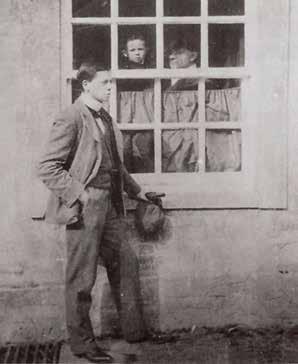

When William Nicholson – who was then 50-something years old – began his affair with the popular novelist Marguerite Steen in the 1930s, he took her on a tour of all his ‘magic’ places. Piled into his sporty MG, they drove to the West Country: to Cerne Abbas with its chalk-dug giant, and to the swan sanctuary at Abbotsbury; they explored a mysterious and tangled yew-tree wood on the Wiltshire Downs. And they went to the beautiful village of Mells in Somerset, where they saw Lady Horner at the old Manor House. She gave them her blessing.
Hard by the 16th-century manor, stood Park House, a handsome hip-roofed neoclassical mansion. It had been designed by Edwin Lutyens for Lady Horner’s niece, Pamela, and her husband Reginald McKenna, the banker and onetime Chancellor of the Exchequer.
For William Nicholson, these two big houses, and the idyllic village that contained them, were indeed places of ‘magic’: over the course of some 40 years, they had established themselves as the centre of a charmed world of long friendships and associations, of encouragement and inspiration.
Nicholson in the mid-1930s had an established reputation as artist, even receiving a knighthood
| Bonhams Magazine 58
Left Portrait of the artist: William Nicholson

in 1936. He also, it should be noted, had a growing reputation as the father of the daring young abstract painter Ben Nicholson.
William Nicholson’s own work might seem conventional, at least in the subjects he chose to represent, but it had always a distinctly original and personal flavour. His youthful creations of the 1890s – the bold posters he made in collaboration with the painter James Pryde under the moniker the ‘Beggarstaff Brothers’, the humorous woodblock-print ‘alphabets’ and ‘almanacs’ of contemporary types that were produced for the publisher William Heinemann –had evolved into a richer painting practice. He was now creating emotive landscapes, reflective still-lifes and – most particularly – fashionable portraits. His success at the latter can be judged from him once complaining, or boasting, that he had “relays of sitters every 20 minutes”. Ben Nicholson was later to praise his father’s still-lifes for their “poetic spirit”, and it is that same spirit that can be traced through all William Nicholson’s work – in combination with the formal virtues of tonal mastery and elegant simplification, or selection.
Nicholson’s pictures have an intimacy that seems to suggest a personal dialogue. They suppose an informed viewer – and they duly attracted many.
Among the best informed was Frances Horner, the presiding genius of Mells. As young Frances Graham (before she married Sir John Horner) she had been the adored muse of Edward Burne-Jones. Indeed, Nicholson had first met her when he went to the artist’s house in Rottingdean in 1897. One of the several daughters of William Graham, who had been the great patron of the Pre-Raphaelites, Frances had been raised to appreciate both art and the artists who made it. So it is no surprise
that she was an early supporter of both Nicholson and Edwin Lutyens.
Other members of the family were supporters, too. Frances’s sister Agnes was married to Sir Herbert Jekyll, a distinguished soldier and public servant, but perhaps better recognised as Gertrude Jekyll’s brother. Gertrude was a celebrated garden-designer and frequent collaborator with Lutyens, and Nicholson would paint a brilliant portrait of her – as well as a no-less-penetrating study of her begrimed gardening boots.
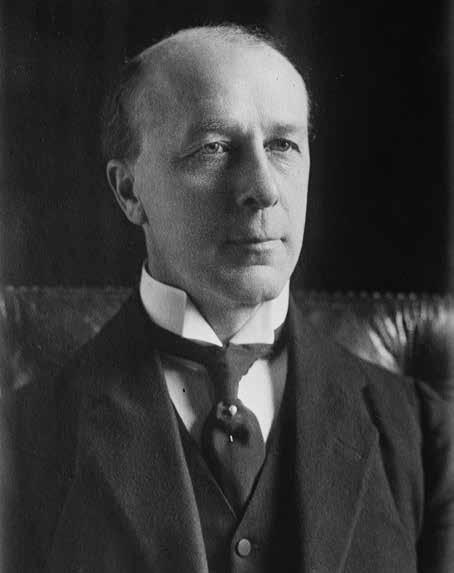

It was the younger daughter of Agnes and Herbert who was the mistress of Park House – and who carried the familial traditions of artistic patronage into the next generation. The house itself was testament to this: she and her husband had commissioned Lutyens to build

| Bonhams Magazine 60
Above Reginald McKenna, Chancellor of the Exchequer, who created a lake to teach his sons, David and Michael, the art of rowing
“Nicholson once complained, or boasted, that he had ‘relays’ of sitters every 20 minutes’”
© Alamy
Left ‘Magic place’: the manor house at Mells Park Below Nicholson painted Michael and David McKenna: The Sons of Mr and Mrs Reginald McKenna as a leaving portrait, given to Eton College
©I Image credit: Nick Smith Photos
Park House after the old, Georgian, house of the same name had burned down in 1917. Nor did the web of relationships end there, for the Jekylls leased the property from the Horners for a peppercorn rent.
Among the works that Nicholson created at Mells was a fine stained-glass window, of St Francis preaching to the fishes, for the Horners’ private chapel – and a charmingly subverted vision of the church itself, as if seen across the fields, with the artist’s own shadow appearing in the bottom part of the picture.
He also celebrated the connection in a series of intimate ‘conversation pieces’ that he created at Park House during the summer of 1927. These are personal and relaxed performances, but sparkling, nonetheless, with that subtle visual wit and technical élan which mark all his paintings,

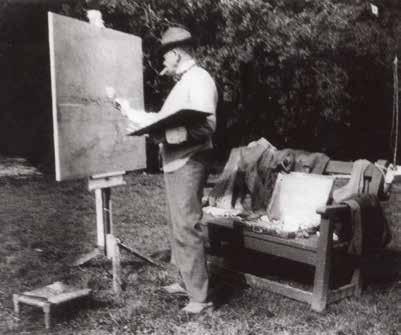
And the spirit and wit of the artist are fundamental to his nature. It should always be remembered, for example, that Nicholson, in his trim little mews studio in Apple Tree Yard, St James’s, kept his paint brushes in an upturned top hat. The conceit proclaimed a playful artistic dandyism, but it also suggested something of the conjurer. Certainly both these strains are reflected in his painting MrsReginaldMcKennaandHerSons, Michael and David – which is offered by Bonhams in the Modern British and Irish Art sale in June.
The picture is a vision of holiday fun, with a flavour almost of Enid Blyton, or of Swallows and Amazons
The scene is the ‘lower lake’ in Mells Park, with its little artificial Seaward Island, which had been created by Reginald McKenna – a prodigious oarsman – so that he could coach his two sons in the arts of rowing from
a stable vantage point. Here, though, it provides a sanctuary for Pamela, who is reading a book on a blue picnic rug, while her sons are busy in the background messing about with boats.
Michael, the figure walking along the top of the cascade, seems almost to be walking on water, until one perceives the line of stepping-stones laid across the line of the weir. The shaft balanced on his shoulder might be a spear but it is an oar. He is followed by two curious beasts – not mythological creatures, as it turns out, but the family golden retriever and the onlyslightly-larger family Shetland pony.
As in almost all of his work, Nicholson delights in the effects of light and the tricks of reflection. Despite the pearlescent grey sky of an English summer’s day, bright sunlight comes shafting in from the side, bouncing off the waters of the lake and the cascade. It catches the ruffled sail of David’s little dinghy and strikes Pamela’s pristine blouse and slender shin – making the whole scene dance, and the viewer along with it. And all of this movement –of light and of water and of life – Nicholson has flashed across an expansive four-foot canvas. It is a brilliant performance. Once again, with that distinctive insouciant flourish, he has pulled it out of the hat.
The most recent book by historian and biographer Matthew Sturgis is Oscar Wilde: A Life
Sale: Modern British and Irish Art London
Wednesday 21 June
Enquiries: Ingram Reid +44 (0) 20 7468 8297 ingram.reid@bonhams.com
Bonhams Magazine | 61 MODERN BRITISH ART
Above William Nicholson painting at Mells Park
Far right
Another portrait of Pamela Mckenna, Mrs McKenna on the Grass, is defined by its bright palette
Travel & Exploration Sale
Thursday 8 June 11am
London
Thomas Baines (1820-1875)
The Victoria Falls, Zambesi River, from the South West (detail)
1863 oil on canvas

45.4 x 66.4cm (17 x 26in)
Estimate: £150,000 - 250,000 ($200,00 - 320,000)
Enquiries: Rhyanon Demery
+44 (0) 20 7393 3865
rhyanon.demery@bonhams.com
Bring on the night
Burgundy has never been short of admirers who are willing to part with eye-watering sums to acquire stellar bottles. As everyone knows, demand has always outstripped supply. Added to the challenge of the small parcels of terroir that predominate in this region is the fact that the weather has not been kind. Recent vintages – 2019, 2020 and 2021 – were all produced in limited quantities, so there were sighs of relief when the 2022 harvest delivered in quantity at least. (Official figures show that 1.75 million hectolitres reached the vats in 2022, compared to 997 million in 2021.) Reports from the rows, however, flag up another concern: the very mild winter. Usually the problem for Burgundy has been inopportune bursts of hail. This year growers are also contending with the early budburst last December, which has left vines exposed to cold snaps.
But that’s for future generations… and, meanwhile, the picture is healthy on the secondary market. According to Liv-ex, the London wine exchange, the list of the 100 most in-demand wines in
the world currently includes 39 Burgundies. In 2017, there were 24. Among the lots for July’s Fine Wine Sale in London is a case of the most sought-after Burgundy of all: Domaine Romanée-Conti. The vintage, 2002, is known for being complex and expressive. With a characteristically deep garnet colour, the 2002 has exceptional length. The case, with an estimate of £100,000 - 140,000, has been donated in aid of The Cure Parkinson’s Trust, a charity Bonhams has long been involved with. While some lovers of Burgundy are fixated on DRC, cognoscenti enjoy exploring other options, not least such revered names as Domaine Georges Roumier and Domaine René Engel.


Since 1924, the Roumier family has presided over vineyards primarily set in the renowned appellations of Chambolle-Musigny and Morey-SaintDenis, some of the most coveted terroirs in the Côte de Nuits. The Musigny Grand Cru from Domaine Georges Roumier is widely regarded as one of the greatest expressions of Pinot Noir in the world. Produced from their tenth of a hectare
vineyard holding in Musigny, the wine is known for its complexity, elegance, and ethereal qualities.

Which brings us to another wonderful wine that is to be offered in July’s sale: the 1999 Grands-Echézeaux from René Engel. This estate’s vineyards span some of the most prized appellations in the Côte de Nuits, primarily in VosneRomanée. The 1999 vintage has long been considered one of the outstanding years in Burgundy – ideal growing conditions produced a vintage characterised by depth, complexity and excellent ageing potential.
It’s no wonder that, when wines from this era arrive on the market, Burgundy continues to exert its mighty pull.
Richard Harvey M.W. is Global Director of Fine Wine at Bonhams.
Sale: Fine and Rare Wines
London
Thursday 6 July
Enquiries: Richard Harvey M.W. +44 (0) 20 7468 5811
richard.harvey@bonhams.com
Bonhams Magazine | 63 WINE
Richard Harvey knows the passion evoked by Burgundy – and the Côte de Nuits is where to look for wines worthy of that passion
Fine Watches
London
Wednesday 21 June 2pm
Patek Philippe. A fine, exceptional and rare platinum perpetual calendar chronograph wristwatch with moon phase

Estimate: £220,000 - 280,000 ($280,000 - 350,000)
Enquiries: Charles Dower charles.dower@bonhams.com +44 (0) 20 7393 3868
XX | Bonhams Magazine
Paris Return to form

The groundbreaking Male Form sale arrives in Paris in early June, hot on the heels of successful previous auctions on the theme in London and New York. Its mission is unchanged: to challenge a market that has traditionally centred on the male gaze. The sale will offer Apocalypse, a monumental work by the Belgian Symbolist painter Emile Fabry that captures his blend of sensuality and power. The Swedish artist Eugène Jansson is represented by At the Door, from the later part of his career when he specialised in male nudes. Scarlet fever in adolescence had left him with chronic health problems, from which he found respite in swimming. Many of his paintings depict fellow swimmers from the navy bath house in Stockholm. With an important sketch by Cocteau, drawings by Tom of Finland, Bubbles by the irrepressible Pierre et Gilles, and images by some of the finest photographers of the male form, the sale once again pushes boundaries and prompts discussion around this historically neglected market.
Image: Apocalypse by Emile Fabry (1865-1966)
Estimate: €60,000 - 80,000
Sale: The Male Form, Bonhams Cornette de Saint Cyr, Paris, 1 June
Enquiries: Matthew Haley, +44 (0) 20 7393 3817 matthew.haley@bonhams.com
Around the
Globe
Andrew Currie highlights a selection of Bonhams’ sales worldwide
Brussels A flowering of imagination
Until recently, the Belgian painter Jane Graverol was probably Surrealism’s best-kept secret. That changed last March, when her Le trait de lumière sold for a world-record price of €579,975 at Bonhams Cornette. From an artistic family – her father was the symbolist painter Alexandre Graverol – Jane had a conventional art academy education but, during the late 1930s, began to experiment with Surrealism. Soon she had become a fully fledged Surrealist artist. In 1950, René Magritte – the godfather of Belgian Surrealism – organised an exhibition of her work and, with her lover Marcel Mariën, she championed Surrealism as a revolutionary movement through the journal Les Lèvres nues. Graverol herself once said: “Surrealism is my escape from the world – it is a search for an indefinable past towards the infinite that we madly search for but do not reach.” This is perfectly encapsulated in La chute de Babylone, the fascinating work from 1967 by Graverol to be offered in Brussels in June. A combination of technique and conscious dreaming (with a nod to the symbolist influence of her upbringing), the work is an ode to freedom and female independence.

Image: La chute de Babylone by Jane Graverol (1905-1984)

Estimate: €50,000 - 70,000
Sale: Art Belge & Contemporain, Brussels, 12 June
Enquiries: Sabine Mund, +32 2 880 73 85 sabine.mund@bonhams-csc.com

Bonhams Magazine |
65
AROUND THE GLOBE
Bonmont A driven man
It isn’t everyone who has a car named after them, but Bugatti afforded that rare honour to the Monégasque racing driver Louis Chiron in 2016. And Chiron certainly deserved the distinction. For more than 30 years from 1927, he raced in everything from rallies to Grand Prix, and remains to this day the oldest driver to compete a Grand Prix race, coming sixth at Monaco in 1955 (he had won there in 1931).
The 1,500hp Bugatti Chiron, unveiled at the Geneva Motor Show as a successor to the Bugatti Veyron, is the marque’s fastest, most powerful production super sports car. An example leads the Bonmont sale in mid-June.
Other highlights include two further rarities: a Ferrari F40, Ferrari Daytona (pictured right) and a Porsche Carrera RS 2.7 Touring. As every year, the cars will be displayed prior to the sale in the grounds of the Bonmont golf club, overlooking Lake Geneva, before coming to auction.

Image: Bugatti Chiron (above)

Estimate: CHF3,000,000 - 4,000,000 Sale: The Bonmont Sale, Chéserex, 18 June Enquiries: Paul Gaucher +41 22 596 75 72 paul.gaucher@bonhams.com
Bruun Rasmussen Juhl in the crown
The world-renowned Danish designer Finn Juhl (1912-1989) trained as an architect, but made his mark as a furniture and interior designer. Juhl differed from many of his design contemporaries in refusing to follow a narrow interpretation of ‘functionalism’ – describing it, with refreshing honesty, as an idiotic word. Juhl looked to modern art for inspiration, shaping his furniture like a sculptor might. He was one of the first Danish furniture designers to be recognised internationally, paving the way for projects such as the interior design of the Trusteeship Council Chamber in the UN Secretariat Building in New York. Juhl’s most famous work includes the Chieftain Chair, the Poet Sofa, the Pelican Chair and the FJ 45 Chair. (Examples can be seen in Juhl’s own house, north of Copenhagen, which is now a museum.) Rare and highly organic pieces by Juhl are offered by Bruun Rasmussen in June, including a pair of chairs and a sofa manufactured by Søren Willadsen around 1950, and inspired by the sculptor Jean Arp.
Image: Two-seater sofa and a pair of easy chairs by Finn Juhl, 1950s

Estimate: DKK300,000 - 400,000 (pair of easy chairs); DKK250,000 - 300,00 (sofa)
Sale: Modern Design at Bruun
Rasmussen, Copenhagen, 12 June
Enquiries: Peter Kjelgaard Jensen +45 8818 1191

pkj@bruun-rasmussen.dk

| Bonhams Magazine
66 AROUND THE GLOBE
New York Star struck
There’s something about the Pre-Raphaelites that appeals to musicians. Take, for example, the ‘Woodlands’ set of nine stained-glass panels designed by Edward Burne-Jones and made at the studio of William Morris in the late 1870s. Five of the panels were once in the collection of rock guitarist and founder-member of Led Zeppelin Jimmy Page, who lived for a time in one of Morris’s former homes – and was perhaps attracted to their astrological theme. Of the remaining four panels, two are untraced, Mars is in Los Angeles County Museum of Art and Sol – the most impressive of the set – will be offered in New York in June. Burne-Jones was commissioned to design the windows for Woodlands by its owner Angus Holden, many times Mayor of Bradford, then later a Member of Parliament. Woodlands was demolished at the end of the 19th century and the whereabouts of the panels remained a mystery until they were rediscovered in the late 1970s. The astrological subject is a rarity for Burne-Jones, who mostly drew on Christian or Classical myth and legend.
Image: Sol by Edward Burne-Jones (1833-1898)
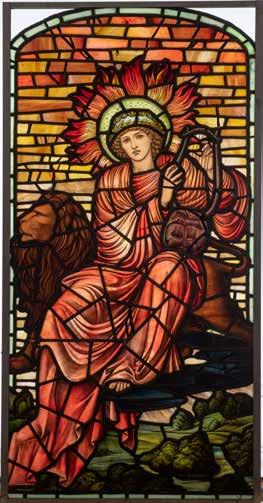
Estimate: $100,000 - 150,000
Sale: Modern Decorative Art & Design

New York, 14 June
Enquiries: Dan Tolson
+1 917 206 1611
dan.tolson@bonhams.com
Hong Kong Blair Zhang
Blair Zhang has joined Bonhams as Head of Business Development, Asia, and Deputy Chairman. Blair’s early background was in international investment banking on Wall Street, with a spell as business developer at Artron Art Group, but he was most recently the chief representative in Hong Kong of Poly Auction. There he drew on his experience in customer development in mainland China to drive high-profile transactions to achieve world-record prices. Based in Hong Kong and Beijing, Blair will be responsible for growing the company’s network of Asian customers, as well as expanding the auction and private sales business in the region.
Enquiries: Blair Zhang blair.zhang@bonhams.com

Los Angeles The entertainer
Roy Eddleman was a remarkable man: scientist, inventor and biotech engineer –he founded Spectrum Labs and Spectrum Medical Industries. He was also a significant philanthropist, raising millions of dollars to help AIDS victims at the height of the crisis, when stigma was considerable and official support non-existent. Ever far-sighted, towards the end of his life – he died in 2022 – he established the Eddleman Center for Quantum Innovation to stimulate progress in quantum science and engineering. The Center will be the beneficiary of the sale in June of the contents of Roy’s palatial Beverly Park home, a sale that reflects his love of entertaining (his annual Christmas party was the signal that the festive season had truly begun). A fine pair of George IV silver wine coolers sits alongside


a 200th anniversary Steinway Grand Piano. A 48-piece armorial Meissen dinner service made by the Dresden company in tribute to the legendary Swan Service rubs shoulders with an American sterling silver flatware service for 24. Perfect for a gregarious man whose professional and private lives enriched those of so many others.
Image: A 48-piece armorial Meissen dinner service
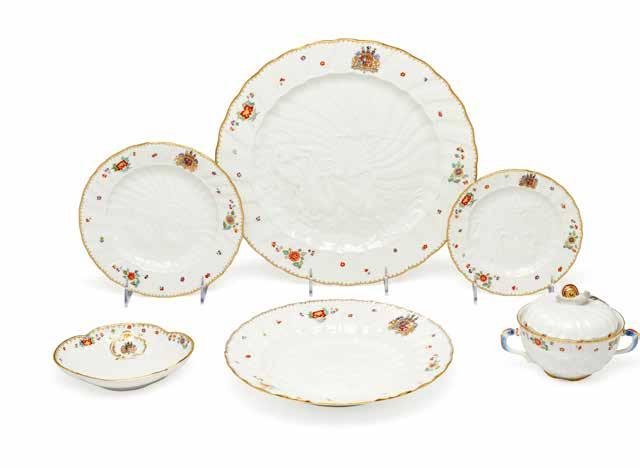
Estimate: $15,000 - 20,000
Sale: Eddleman SOS, Los Angeles, 14 June
Enquiries: Anna Hicks +1 323 436 5463 anna.hicks@bonhams.com
AROUND THE GLOBE
Paris Feeling bullish
The 50th anniversary this year of the death of Pablo Picasso is an opportunity to reflect not only on his achievements as a painter but also on some of the less explored aspects of his artistic output. The Picassomania sale does precisely that, shining a light, in particular, on Picasso the ceramicist and printmaker. Although Picasso had experimented with ceramics during his adolescence, it was not until the summer of 1947 that he embraced the medium seriously, after a visit the previous year to the Madoura pottery in Vallauris on the Côte d’Azur. Never a man to do anything by halves, Picasso had by the end of 1948 produced 2,000 unique pieces, among them Visage noir putoisé – which is offered in the
Bukowskis By royal appointment

The Golden Jubilee of King Carl XVI Gustaf of Sweden on 15 September 2023 marks his 50 years on the throne. By coincidence, it falls in the 500th anniversary year of Gustav Vasa being elected King of Sweden. Since at least the time of Gustav Vasa, who is recognised as ‘the father of the nation’, the Swedish monarchy has been giving precious and thoughtful gifts to loyal citizens and to members of the wider royal family as a sign of appreciation and good will. These range from simple coins and medals to elaborate gold boxes, jewellery and other valuable items, all of which help tell the story of Swedish cultural heritage. To mark the double royal celebration, Bukowskis – holder of a royal warrant of appointment –has chosen to highlight a selection of exceptional art and craft objects with royal provenance (many of them gifts) in a curated section of the Important Spring Sale that reflects royal patronage and taste. A unique opportunity to acquire an important part of royal history, the sale offers artefacts such as an exquisite Royal Gold double salt cellar and a gold egg server, both commissioned by King Carl XIII and made in 1811 by Michaelsson & Benedicks of Stockholm.
Image: A Royal Gold double salt cellar by Michaelsson & Benedicks of Stockholm, 1811

Estimate: SEK150,000 - 175,000
Sale: Important Spring Sale, Stockholm, 14-16 June

Enquiries: Carl Barkman, +46 (0) 70 892 1971 carl.barkman@bukowskis.com
Edinburgh Lines in the sand
For centuries, sand painting has had cultural and religious significance around the world. Its popularity as a decorative art, however, is down to George III. A keen and skilled craftsman himself, the King was fascinated by the table deckers, who decorated tablecloths at royal banquets with ornate centrepieces using unfixed coloured sands and sugars as ‘paint’, and a bird’s feather as a ‘brush’. He suggested that, instead of discarding the display after each event, a means should be found to preserve them for reuse. The German artist Benjamin Zobel – a master table decker –devised a way to build up layers of coloured sand and fix them into place. One of his sand paintings, A Farmyard Scene, features in the Folk Art, Naïve Paintings and Vernacular Furniture online
sale. Other highlights reflect his endless fascination with bullfighting and include La Tauromaquia, a complete portfolio from 1959 of 26 sugar-lift aquatints and an additional suite from the deluxe edition of 30 printed by Atelier Lacourière, Paris, published by Ediciones de la Cometa, Barcelona.
Image: La Tauromaquia by Pablo Picasso (1881-1973)
Estimate: €45,000 - 65,000
Sale: Picassomania Bonhams Cornette de Saint Cyr, Paris, 28 June


Enquiries: Lucia Tro Santafe +33 (0) 1 4261 1010 picassomania@bonhams.com
sale in Edinburgh in June. Other highlights include Asking the Way, a charming early 19th-century naïve painting, a rare Tudor pewter plate, and a wonderful late 16th-century mythological and biblical carved walnut panel from the collection of the distinguished art historian Dr Alfred Scharf, who fled to England from Nazi Germany in 1933.
Image: A Farmyard Scene by Benjamin Zobel (1762-1830)

Estimate: £700 - 1,000
Sale: Folk Art, Naïve Paintings and Vernacular Furniture, Edinburgh 31 May-7 June
Enquiries: Kenneth Naples +44 (0) 131 240 2630 kenneth.naples@bonhams.com
| Bonhams Magazine 68 AROUND THE GLOBE
Post-War & Contemporary Art
London
Thursday 29 June 4pm
Tom Wesselmann (1931-2004)
Monica Nude with Matisse (Black variation #3), 1987/91 enamel on cut-out steel

129.5 x 218.4cm (51 x 86in)
Estimate: £150,000 - 200,000 ($190,000 - 250,000)
Enquiries: Irene Sieberger +44 (0) 20 7468 5873 irene.sieberger@bonhams.com
Bonhams Salerooms & Offices Worldwide
Bukowskis Arsenalsgatan 2 Box 1754, 111 87 Stockholm, Sweden
+46 8 614 08 00
Copenhagen
Bruun Rasmussen Bredgade 33 1260 Copenhagen, Denmark +45 8818 1111
MIDDLE EAST
AFRICA
Nigeria
Neil Coventry +234 (0) 8110 033 792 +27 (0) 7611 20171 neil.coventry@ bonhams.com
South Africa –Johannesburg
Penny Culverwell +27 (0) 71 342 2670 penny.culverwell@ bonhams.com
AUSTRALIA
Sydney 97-99 Queen Street, Woollahra, NSW 2025
Australia
+61 (0) 2 8412 2222
+61 (0) 2 9475 4110 fax info.aus@bonhams.com
Melbourne
1130 High Street
Armadale VIC 3143
Australia
+61 (0) 3 8640 4088
+61 (0) 2 9475 4110 fax info.aus@bonhams.com
ASIA
Beijing Vivian Zhang Unit C610, Beijing Lufthansa Center, 50 Liangmaqiao Road, Chaoyang District, Beijing 100125, China
+86 (0) 10 8424 3188 beijing@bonhams.com
Shanghai
Wang Jie Room 409,4th Office Building, International Equatoral Hotel No.65, Yan An Road West, Jing An District Shanghai 200040, China
+86 (0) 21 6248 0258 shanghai@bonhams.com
Singapore Yunwen Sung
11th Floor, Wisma Atria 435 Orchard Road
Singapore 238877
+65 (0) 6701 8038
+65 (0) 6701 8001 fax Yunwen.Sung@bonhams. com
Taiwan
Bobbie Hu
Suite 2012, 20F, No. 333, Section 1 Keelung Road Xinyi District, Taipei 110, Taiwan +886 2 2757 7070 taiwan@bonhams.com
EUROPE
Belgium
Wilfrid Vacher
Christine de Schaetzen
Chaussée de Charleroi, 89 1060 Brussels
+32 (0) 2 880 73 80
+32 (0) 2 736 50 76 belgium@bonhams.com
France Catherine Yaiche
catherine.yaiche@ bonhams.com
6 avenue Hoche
75008 Paris
+33 (0) 1 42 61 10 10 paris@bonhams.com
Germany – Cologne
Andrea von Bredow +49 152 021 562 01 andrea.vonbredow@ bonhams.com cologne@bonhams.com
Germany – Düsseldorf and Northern Germany
Eva Lengler +49 176 698 580 73 eva.lengler@bonhams.com dusseldorf@bonhams.com
Germany – Frankfurt
Andrea von Bredow +49 69 509 55 209 andrea.vonbredow@ bonhams.com frankfurt@bonhams.com
South of Germany
– Münich & Austria
Katharina Upmeyer
Maximilianstrasse 52 80538 Münich +49 (0) 89 2420 5812 katharina.upmeyer@ bonhams.com munich@bonhams.com
Greece
7 Neofytou Vamva Street
Athens 10674 +30 (0) 210 3636 404 athens@bonhams.com
Ireland
Kieran O’Boyle kieran.oboyle@ bonhams.com
31 Molesworth Street Dublin 2 +353 (0) 1 602 0990 ireland@bonhams.com
Italy – Milan
Benedetta Alpini benedetta.alpini@ bonhams.com Via Boccaccio 22 20123 Milano +39 0 2 4953 9020 milan@bonhams.com
Italy – Rome
Emma Dalla Libera emma.dallalibera@ bonhams.com
Via Sicilia 50 00187 Roma +39 06 485 900 rome@bonhams.com
The Netherlands
Charlotte Roelofsen charlotte.roelofsen@ bonhams.com
De Lairessestraat 154 1075 HL Amsterdam +31 (0) 20 67 09 701 amsterdam@ bonhams.com
Portugal Filipa De Andrade filipa.deandrade@ bonhams.com
Rua Bartolomeu Dias no160. 1o
Belem
1400-031 Lisbon
+351 218 293 291 portugal@bonhams.com
Spain – Barcelona & North Teresa Ybarra
teresa.ybarra@ bonhams.com
+34 930 156 686
+34 680 347 606 barcelona@ bonhams.com
Spain – Madrid
Johann Leibbrandt johann.leibbrandt@ bonhams.com
Núñez de Balboa no 4-1C 28001 Madrid
+34 915 78 17 27
Switzerland – Geneva
Nina Skunca nina.skunca@bonhams. com Rue Etienne-Dumont 10 1204 Geneva
+41 22 300 3160 geneva@bonhams.com
Switzerland – Zurich
Andrea Bodmer andrea.bodmer@ bonhams.com Stockerstrasse 12
8002 Zürich
+41 44 281 9535 zurich@bonhams.com
NORTH AMERICA
USA
Representatives: California –Palm Springs Brooke Sivo brooke.sivo@ bonhams.com
+1 (760) 567 1744 palmsprings@ bonhams.com
California – San Diego Brooke Sivo brooke.sivo@ bonhams.com
+1 (760) 567 1744 sandiego@ bonhams.com
Florida Kate Stamm kate.stamm@bonhams.com
+1 (561) 319 2586
Luis Torres luis.torres@bonhams.com
+1 (929) 215 1621 miami@bonhams.com
Illinois & Midwest
Natalie B Waechter natalie.waechter@ bonhams.com
+1 (773) 267 3300 chicago@bonhams.com
Nevada – Las Vegas
Brooke Sivo brooke.sivo@ bonhams.com
+1 (760) 567 1744 lasvegas@bonhams.com
Oregon & Idaho
Sheryl Acheson sheryl.acheson@ bonhams.com
+1 (971) 727 7797 oregon@bonhams.com
San Francisco 601 California Street Suite 150 San Francisco CA 94108
+1 (415) 861 7500 info.us@bonhams.com
Texas – Dallas & Houston Mary Holm mary.holm@bonhams.com
+1 (214) 557 2716
Brandon Kennedy brandon.kennedy@ bonhams.com dallas@bonhams.com
Washington & Alaska
Heather O’Mahony heather.omahony@ bonhams.com
+1 (206) 566 3913 seattle@ bonhams.com
Canada
Toronto, Ontario
Kristin Kearney 340 King St East Toronto ON M5A 1 KB kristin.kearney@ bonhams.com +1 (416) 462 9004 info.ca@bonhams.com
Representatives: Vancouver, BC Cailin Broere cailin.broere@ bonhams.com +1 (604) 841 7315 info.ca@bonhams.com
Israel Joslynne Halibard joslynne.halibard@ bonhams.com +972 (0) 54 553 5337
UNITED KINGDOM
South East England
Brighton & Hove
Representative: Tim Squire-Sanders +44 1273 220 000 hove@bonhams.com
Guildford Millmead, Guildford, Surrey GU2 4BE +44 1483 504 030 guildford@ bonhams.com
Isle of Wight +44 1273 220 000 isleofwight@ bonhams.com
West Sussex +44 (0) 1273 220 000 sussex@ bonhams.com
Thames Valley
Oxford
Banbury Road Shipton on Cherwell Kidlington OX5 1JH +44 1865 853 640 oxford@ bonhams.com
South West England
Bath
Queen Square House Charlotte Street Bath, BA1 2LL +44 1225 788 988 bath@bonhams.com
Dorset
Representative: Emma Sykes +44 1225 788 982 bath@bonhams.com
Exeter Richmond Court, Emperor Way, Exeter, Devon, EX1 3QS +44 1392 425 264 exeter@bonhams.com
Tetbury Eight Bells House 14 Church Street Tetbury
Gloucestershire GL8 8JG +44 1666 502 200 tetbury_office@ bonhams.com
Truro 36 Lemon Street Truro TR1 2NR +44 1872 250 170 truro@bonhams.com
Midlands Knowle 21B Station Road Knowle, West Midlands B93 0HL +44 1564 776 151 knowle@ bonhams.com
Yorkshire & North East England
Leeds, North East, Lincolnshire & Nottinghamshire The West Wing Bowcliffe Hall Bramham Leeds, LS23 6LP +44 113 234 5755 leeds@bonhams.com
East Anglia Bury St Edmunds
Representative: Michael Steel +44 1284 716 190 bury@bonhams.com
Norfolk and South
Lincolnshire Representative: Claire Tuck +44 1603 871 443 norfolk@ bonhams.com
North West England Chester, North West and North Wales 2 St Johns Court Vicars Lane Chester, CH1 1QE +44 1244 313 936 chester@ bonhams.com
Manchester Representative: Antony Bennett +44 161 927 3822 manchester@ bonhams.com
Channel Islands
Guernsey Representative: Angela Peel +44 1481 722 448 guernsey@ bonhams.com
Jersey La Chasse La Rue de la Vallée St Mary Jersey, JE3 3DL +44 1534 722 441 jersey@bonhams.com
Scotland
Glasgow/West of Scotland
Representative: Gordon McFarlan +44 141 223 8866 glasgow@ bonhams.com
Wales
Cardiff Representative: Emma Sykes +44 292 072 7980 cardiff@bonhams.com
INTERNATIONAL SALES DIARY
All sale dates are subject to change. Readers are advised to contact the department concerned for exact details. For information and details of sale dates, or about the objects and paintings pictured, please contact Customer Services at Bonhams New Bond Street on +44 (0) 20 7447 7447. Please note: London 101 New Bond Street London W1S 1SR +44 (0) 20 7447 7447 Montpelier Street London London SW7 1HH +44 (0) 20 7393 3900 Paris Bonhams Cornette de Saint Cyr 6 avenue Hoche +33 (0) 1 42 61 10 10 Brussels Bonhams Cornette de Saint Cyr 89 Chaussée de Charleroi 1060 Brussels +32 (0) 2 880 73 80 New York 580 Madison Avenue New York, NY 10022 +1 (212) 644 9001 Los Angeles 7601 W Sunset Boulevard Los Angeles CA 90046 +1 (323) 850 7500 Boston Bonhams Skinner Marlborough 274 Cedar Hill St, Marlborough MA 01752 +1 508 970 3000 Bonhams Skinner 63 Park Plaza, Boston MA 02116 +1 508 970 3211 Hong Kong 20/F One Pacific Place 88 Queensway Admiralty, Hong Kong +852 2918 4321 Edinburgh 22 Queen Street Edinburgh EH2 1JX +44 131 225 2266 Sydney 97-99 Queen Street, Woollahra, Sydney NSW 2025 +61 2 8412 2222 Stockholm
70 | Bonhams Magazine
Prints and Multiples
Online, Los Angeles
Tuesday 13 - Friday 23 June 10am
Peter Alexander (1939-2020)
Gardena, from Barcelona Portfolio, 1988 (detail)

Lithograph in colors
46 x 51.1cm (18 x 20in)
Estimate: $1,500 - 2,000
(£1,300 - 1,600)
Enquiries: Morisa Rosenberg
+1 323 436 5435 morisa.rosenberg@bonhams.com
My Favourite Room
Well, I had lots of ideas for this: restaurants and galleries and even a railway station in need of preservation, but I am not going to pretend. My favourite room is still the room in the first house I bought 40 years ago now, on the very edge of south Suffolk, facing east towards Holbrook Ness. I thought then that I had found domestic perfection.
It is not hugely big, about 22 feet by 15 feet, and a box, really, but it would have been the centre of a working farm, so it has a pamment floor of the same yellow bricks that Suffolk explorers will recognise from churches in the area. There is a slight step down from the dark hallway (added in the 19th century and later restored and improved), so I guess that the original owners in the 17th century would have walked straight in.
As you enter, there is a large brick fireplace and stack to the left. We stuck a stove in there. I love that stove, too. We are in the middle of the countryside. The wind carries particulate matter away, up the big chimney (down which Little Owls sometimes venture and get into the parlour on the other side) and out to sea. I cannot comprehend the desire to outlaw such vital elements of country existence.

Above your head are beams which in the 18th century were enclosed in simple beaded, painted panels. On either side of the one nearest the kitchen is a message, painted on tin. It reads ‘Stutton Bounds in this beam 1836’. Cross under the beam and the message is ‘Holbrook Bounds in this beam’. The house straddles the two parishes. The signs are the reason the place was listed when the farmhouse fell into dereliction in the Sixties.
We furnished it as simply as possible, with benches and two Irish hand-made chairs, around an old deal pub table. (The latter suits it so well that I bought and installed it six months before we owned the place).
Apart from a stuffed eel that I bought in Hay-on-Wye and a sailor’s shell valentine, which now seem to have become collectable, there are two Regency-era pastel portraits on the wall above a 1920s ‘dairy cupboard’. The likenesses came from a dealer in Westbourne Grove. He told me he thought they were of Suffolk origin, but I think they are Dutch – only because I once crossed the North Sea on the ferry I can see from the bottom of the garden and saw many similar in Utrecht.
It’s that window on to that garden that makes the room, though. A large, crooked sash affair, built into a plaster oblong front installed in the 18th century, it ushers in the Constable skies and the prospect of a swelling Suffolk field-scape, dotted with oaks, that sweeps down to flat Holbrook Bay, and another similar set of farm buildings on a promontory in the far distance.

In the foreground is the garden we made over 30 years. We no longer live in this house. Guests rent it as a holiday home, set in eight acres of gardens, and we live next door.
Award-winning actor Griff Rhys Jones is also President of the Victorian Society.

| Bonhams Magazine 72 PEOPLE AND PLACES
There’s no place like home – to be precise, says Griff Rhys Jones, my first home
“I thought then that I had found domestic perfection”

Bonhams | Cars introduces a rebrand of its international motoring department, complete with a dedicated website for collector cars, motorcycles, and automobilia, which is live now at BonhamsCars.com. Buy and sell your collector car anywhere, anytime—live or online. Discover the new BonhamsCars.com














































































































































































